- UFR Droit Economie Management
- UFR Médecine
- UFR Pharmacie
- UFR Sciences
- UFR Sciences du Sport
- AgroParisTech
- CentraleSupélec
- ENS Paris-Saclay
- Institut d'Optique
- Polytech Université Paris-Saclay
- Accessibility
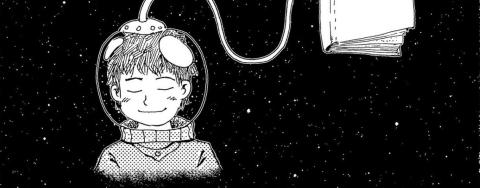

How's your PhD thesis comic stripping?
Since 2021, several PhD candidates from Université Paris-Saclay have been exhibiting their research topic on two comic strips each year. The 'La recherche sort de sa bulle' (Research breaks out of its bubble) project, organised by La Diagonale Paris- Saclay, offers students a series of workshops with illustrator Marine Spaak to help them create their own comic strip. As part of the Science with and for Society (SAPS) label, PhD candidates disseminate their research outside the academic world and to a wider audience.
This article was originally published in L'Edition n.23.
" What is the point of research if it never leaves the lab bench? " This question has been taken up by La Diagonale Paris- Saclay ,the arts, culture, science and society department of Université Paris- Saclay. Its mission is to bridge the gap between scientific activities and the rest of society; it is committed to making science accessible to everyone, by every possible means, and in particular by using visual media. In addition to creating videos, podcasts and board games, Charlène Corty, in charge of scientific outreach at La Diagonale, has been organising 'La recherche sort de sa bulle' workshops for the past two years.
This Université programme is modelled on 'Sciences en bulle' (Science in a bubble), an initiative of the French Ministry of Higher Education and Research (MESR), which selects ten French PhD candidates each year. These ten winners are then asked to write a comic strip on their thesis topic. But, as Charlène Corty points out, " every year, we get several interested people " from all over the Université Paris-Saclay campus. For the past two years, the Université has been offering its PhD candidates an education programme on writing comics. In these workshops, funded by the MESR's SAPS label, interested PhD candidates aim to create two comic strips showcasing their research topic. Accompanied by illustrator Marine Spaak, the students draw up a storyboard, which is a document containing the text, layout and visual ideas for the comic strip. The illustrator then finalises the drawings and colourisation.
Education for PhD candidates
Students develop their own story boards during the four education workshops. They proceed in stages and face a number of challenges. The first difficulty is space constraints: " Two times six comic strips is not a lot ," comments Kévin, who took part in the 2022 edition. So you have to choose the messages you want to get across, prioritise them and, if necessary, sacrifice the less important ones for the sake of clarity.
This first written section precedes the section devoted to the specific features of the comic strip, including the correct division of the message and the message assigned to each box. Finally, the last stage is visual and focuses on sketching the first drawings. For Alice, another participant in the 2022 edition, the challenge is " to illustrate your thesis. It's not easy to use humour ." According to the PhD candidate, the contribution of an outside viewpoint from other PhD candidates as well as nonresearch supervisors during group workshops is invaluable. " They give us feedback that we don't expect at all but which really helps ," says Alice.
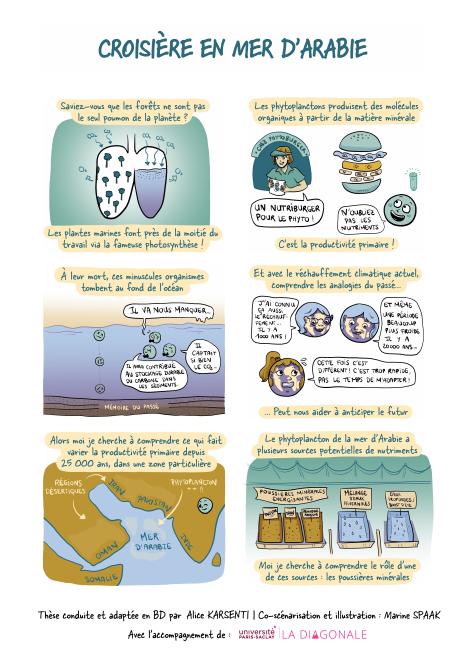
Comics as a special means of disseminating scientific information
For PhD candidates, this experience of writing comics is a step towards improving their ability to popularise science. It can be combined with other programmes run by Université or the MESR, such as ‘Ma Thèse en 180 secondes’ (My Thesis in 180 seconds) or the annual Science Festival. The strength of comics lies in their ability to concentrate a great deal of information, using both text and drawing. " In comics, you can tell a lot of stories in a single box ," notes Alice. Furthermore, visual media are often considered more accessible by the public and help to demystify research. " People close to me pointed out that it was easier to understand my research thanks to comics ," says Kévin.
You can find all the comic strips of 'La recherche sort de sa bulle', including the 2023 creations with the illustrator Alice Varoquaux on the Science & société website .

Culture doesn't fit in a box. Neither do we.
Comics Academe: How To Write a Comics Dissertation
Out there, somewhere, is a woman who writes about comics who wants to turn that writing to a comics dissertation or thesis, or at least I sure hope there is! The field is wide open and ready for more. For the uninitiated, a dissertation or thesis is the long essay or project that serves as the capstone for most advanced degrees (especially doctoral degrees) in the sciences and humanities. There is some degree of coursework or class-type work in most programs, but this is the project that determines whether or not you earn the degree. The nature and form of these projects has been under debate in recent years , but the actual production of some object that concludes the PhD remains a constant. The internet has worked alongside the fast-moving and collaborative nature of digital scholarship in general to jolt the usually slow-to-change academic establishment. By making wide varieties of information more available to a wider public and expanding the possibilities of collaboration, digital forms of scholarship have disturbed the idea of authority. This idea of authority is what allows some group to grant a degree to someone else. You can see why this sort of debate can be disturbing!
What I’ll talk about most here is writing about comics in a dissertation as opposed to writing a dissertation as a comic. Be warned: the minute you start pairing talk of “comics” and “dissertation” people are going to assume you’re writing a comic. For some of you, this will be a fantastic way to go. If your committee has trouble imagining your dissertation as a comic, you might point out Nick Sousanis’s recently published comics dissertation Unflattening . His process bringing the dissertation into comics form is lovingly documented all over the internet by academics and comics people alike, such as here , here , and here . Such a precedent is wonderful to present to a wary committee. If their hesitation comes from fears that you won’t be taken seriously, it’s nice to have a publication from Harvard University Press to point out. Of course, you should listen to your committee, more on them in a moment.
I, personally, want to see more dissertations with/about/using comics in a variety of fields, and I want everyone to have a good time. So, I’m going to offer you some advice. This particular set of advice features an emphasis on surviving a comics-centric humanities-based academic endeavor. I’ve survived it. You can, too, Woman Who Wants to Write about Comics in a Dissertation.
Find Your Peers
If you want to use comics as your subject or a major player in your dissertation, you want find your comics-studying peers as quickly as you can. Especially if you are adding comics to some other academic field, you should start seeing out your comics-peers and comics study well before you are ready to dissertate. Don’t dive in half-ready. Besides doing diligent research on comics themselves, include a search for comics-related dissertations already around.
ComicsResearch.org maintains a list of comics-related dissertations and theses that anyone can access, but use the full power of your university library and databases to seek out a wide array of related projects before you begin your own. I can almost guarantee that you’ll learn something from the scope of the dissertations that have come before yours.
Extensive research before you begin in earnest can assuage what my friends call that feeling of “disencouragement” that comes when you find some work that looks a lot like your thing but not exactly like your thing. You want similar work that assures you you have something to add to an active conversation, not to find that you’re not as original as you thought! Doing this before you solidify your committee can help you figure out who you want on it, as well.
Find Your Committee/Pick Your Audience
The Dissertation Committee in most graduate programs is made of three or four senior scholars who already have the degree you are striving to earn. These people are the gatekeepers for your degree and the primary audience for your project. As such, it’s important to choose wisely. Not every program will have a faculty member that uses comics the same way you do in your work (some day I should write a post about choosing a graduate program).
The head of the committee (the head of your Voltron) is the most important member. You want someone who plays well with other faculty and who has the most depth of knowledge around the particular project you are creating. You want an organized person who answers your emails in a reasonable amount of time and gives you critical feedback. You want them to challenge you. The rest of the committee follows this person. Make sure they are game for the kind of project you are pitching! You want this person to be comfortable criticizing your work and giving you a bit of a hard time. That makes it better. You also want someone who can understand why your work is of value. That makes it better, too.
Committees are hard to put together anyway, but sometimes committees on comics projects can be extra difficult. In the United States, we struggle mightily with a stigma around comics that not only marks them as lowbrow, but in the 1950s, as anti-academic and even anti-American. Many of the people in academia ow grew up around these ideas. Don’t shout them down! Listen to their objections carefully. Take their advice. Make your project better than they expect it is possible to be.
Form a Writing Group
Support for your comics project can come from other areas, too. Your writing group might be gleaned from a group of fellow fans or people you find through social media who share an interest in your niche of the comics world. I found academic friends over at Sacred and Sequential who share my love of both comics and the study of religion. It was great having all these scholars to talk to during the process. Sometimes having confirmation that there are other people out there studying comics seriously was an incredible boost.
Push it FURTHER
Dissertations require an incredible amount of work; make it work that means something to you. Once you’ve done your review of the available literature, try to make your project do something other than what’s been done. Inevitably, you’re going to knock against other people doing this comics work, but the field is still so wide open that you’re also going to find yourself enjoying these brief moments of fellowship with other people who value this work.
We live in a delightful age of interdisciplinarity. The academy is noticing that fields that play well with others have much to offer the world. If you’re thinking, “I’m not getting a fine arts degree, how can I talk about comics in the field of X?”, let me give you an idea: My degree is a PhD in Religious and Theological Studies from a joint program between the University of Denver and the Iliff School of Theology. My concentration is in Biblical Interpretation. Nothing about this screams comics? Hold onto your hats! My dissertation is called “ Imagining the Scandal of the Cross with Graphic/Novel Reading . ” In this study, I read the crucifixion of Jesus through the lens of several modern comics that treat the idea in a range of provocative ways in order to breath life into an interpretation of the views of two New Testament authors. In short, I show how comics can help shake up biblical scholars when their imaginations are stuck.
I think there are plenty of other fields that could use this sort of a shake up in all kinds of ways. After all, if you can think it, there’s a comic about it. I see no reason why there can’t be a dissertation about it, too. Because comics is still a newish field—maybe it’s not that new anymore, but the study of religion and the Bible is either, about 100, around 350, or maybe closer to 1700 years old, depending on how you’re counting. This kind of time gives fields the chance to become established in a way that comics studies is only beginning to enjoy in some places. But, comics studies has a youth that makes it nimble. We have a chance to make the conversation more than defensive and on into something truly meaningful—about the ways we tell our human stories to one another with text and pictures in whatever combination we please.
Don’t Give Up
In every dissertation process—every single one—there is at least one moment where you are going to feel like you are at the end of your writing-rope. Dissertations are painful. Be gentle with yourself. This process requires support from a network of people, some of whom you will know and some of whom you will only read. Draw strength from these people, both the living and the written. Understand yourself as a part of a community of scholars and writers.
If you’re writing a dissertation on comics or with comics or that is in any way comics-related, you’ll find other people can sometimes be a unique challenge. Instead of allowing these nay-sayers to control the conversation in your head, immerse yourself in the work of people who take these fantastic creations seriously, who find them worthy of critique. Find strength in the magic of comics. Let yourself feel a shiver occasionally when you recognize a moment of true invisible art . Don’t give up. The rest of us need your work!
Dr. Elizabeth Coody completed her dissertation in May 2015. She loves her committee. However, she’s still not quite over the experience, and would like to do what she can to help those who follow.
Elizabeth Coody
Leave a reply cancel reply.
Your email address will not be published. Required fields are marked *
This site uses Akismet to reduce spam. Learn how your comment data is processed .
Related Posts
Review: aliens: what if.. tries to find sympathy for its devil, previously on comics: short, but not sweet, essay: dead at 55: barbara’s zombie chronicles (2004).
- Style & Fashion
- Art & Design
- Roundtables
- Con Diaries
- Comics Academe
To revisit this article, visit My Profile, then View saved stories .
- Backchannel
- Newsletters
- WIRED Insider
- WIRED Consulting
Julia Powles
PHD comics' Jorge Cham on misery, hope and academia
Jorge Cham, creator of the cult comic strip Piled Higher and Deeper , or PHD, is probably the most gut-achingly funny/tragic counsellor you could recommend to a PhD student -- or to any confounded friend, lover, or parent trying to understand what he terms, with some flourish, the "global misery phenomenon" of graduate school.
Cham is a full-time cartoonist, but the deep scars wrought by a PhD programme (in robotic engineering) remain his constant muse.
His webcomic has been running since he started grad school in 1997, is syndicated worldwide, and attracts a loyal following among that peculiar breed of poorly-paid, slightly masochistic overachievers, bravely hunting the frontiers of knowledge, free food, most random societies on campus, and unrequited supervisor approval.
PHD follows the travails of four main characters in grad school: the nameless, hapless hero that bears considerable resemblance to Jorge; Cecilia, the reluctant geek constantly frustrated by undergraduates; Tajel, the free-living social sciences student always willing to rally for a cause; and Mike Slackenerny, that person -- every research group has one -- who has been there longer than anyone can remember. The students' harried encounters with the demanding, loveless Professor Smith and absent-minded Professor Jones form the foundation for many priceless recurring gags, poking fun at the lows of grad student life.
Recently, Jorge was in the UK on an academic world tour , talking about 'The power of procrastination'. His thesis has something for all of us -- grad students and otherwise.
The power of procrastination
"The first thing to note", says Cham, "is that procrastination is not the same thing as laziness. Laziness is when you don't want to do anything. Procrastination, its close but distinct cousin, is when you don't want to do the one thing you really ought to be doing, right now. It's not that you don't want to do it, it's just that you find doing everything else possible, from some completely obscure hobby to categorising the entire internet, like the Yahoo dudes did when their supervisor was on summer break, more appealing."
How much time do you spend on a given comic?
I doodle and brainstorm on a notebook I always carry with me. It can take anywhere from five minutes to eight hours to work out a comic. Drawing it on the computer (using a Cintiq) usually only takes one hour.
Simon Singh has written a whole book about mathematics and The Simpsons . Have you got some examples of deep-coded nerd gags in your comics?
I always try to generalise things because my audience spans so many disciplines, but I do have a running gag that pi/2 is always the answer, and I've lost count how many times I've hidden 1.57 into my comics over the years.
Can you give away anything about your characters?
Increasing the ratio of female professors is a big topic I hope to address in the future. The nameless grad student was given a name in The PHD Movie (the film adaptation of the comics), but it's not clear yet whether that's canon or not.
The comics will eventually follow the characters to the completion of their time in grad school. One graduated several years ago (and is now a Post-doc), and I think another will graduate in the next year or two.

Kate Knibbs

Dell Cameron

Medea Giordano
You mentioned The PHD Movie . I've heard there's a sequel in the pipeline. Tell us about it.
Yes, we're trying to make a sequel to The PHD Movie ! A few years ago we made what I think is the first independent movie adaptation of a webcomic, and it was a great success in the academic world. It screened at over 500 universities and research centres worldwide (including Antarctica) and got great reviews.
Recently, I've gotten a lot of inquiries whether we're going to make a follow-up so I decided to give the fans a chance to make it happen by launching a Kickstarter . What's different about these movies is that they involve real scientists, researchers and staff members at a real top university (Caltech) in the acting and producing roles.
Part of the message we want to convey is that people in academia are not robots, that they have different passions, talents and even a sense of humour. So, the movie is in the hands of the internet to make it a reality.
Do you have a favourite PHD series?
I started listing out some of my favourite series, but then I realised another reason it's great to be a creator online is that it sort of doesn't matter how many people appreciate any particular piece of work you do. As long as you create something that has meaning to you, you will most likely find others who also connect with it, and the connection will probably be deeper than if you tried to create something that you think everyone would like. It's also easier to take risks because if people didn't particularly like something you did, you have your whole archive there for people to also sample and find something they like.
Is there one comic that stands out as particularly special to you?
One particular comic I've done that comes to mind is a version of Alice in Wonderland where Cecilia gets pulled through her monitor into Thesisland, as a metaphor for her feeling lost on her research. It's a series of comics I feel that works on different levels (character, arc, story, artwork, punch-lines). I also wrote and drew them during the first few weeks my son was born, so it's special also because I was somewhat inspired by that. It's not one I'm particularly famous for, but every once in a while someone will come up to me to say it's their favourite too.
You can see the 11 part series online, starting here and ending here .
The PHD Movie is available to watch for free all this month . You can fund the sequel through this Kickstarter campaign
This article was originally published by WIRED UK

Angela Watercutter

Aaron Gordon

Madeline Ashby

Jennifer M. Wood

20 Comics Follow the Lives of Graduate Students and the Challenges of Academia
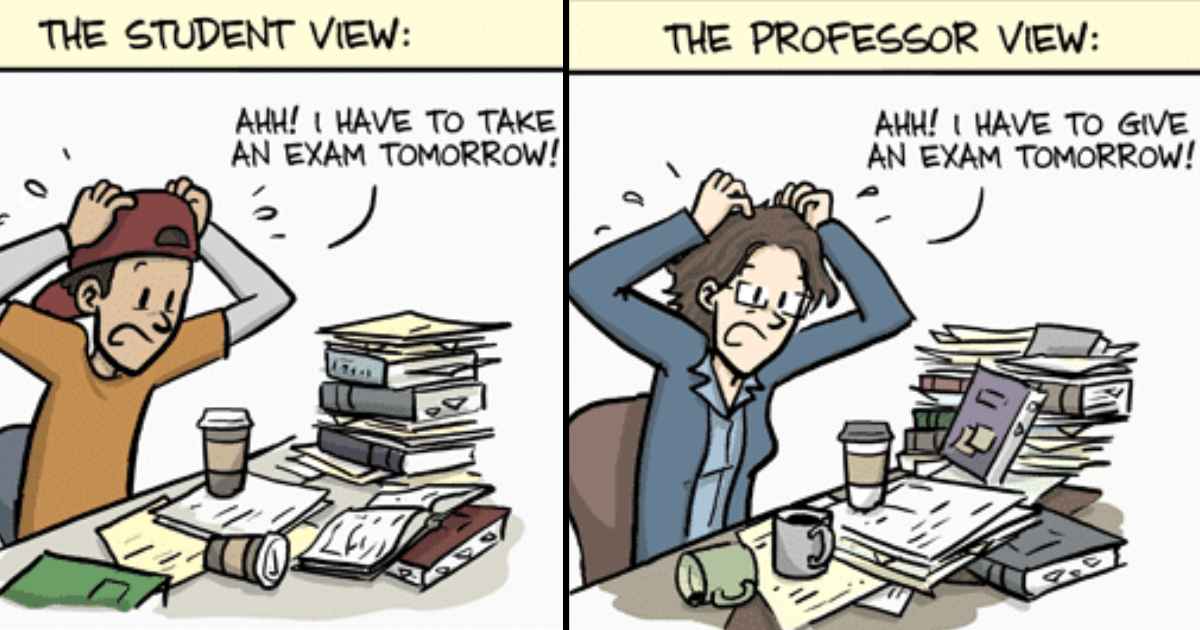
The lives of graduate students are a unique blend of academic rigor, personal growth, and numerous challenges. These individuals are pursuing advanced degrees, such as Master’s or Ph.D. programs, and are deeply involved in research, teaching, and scholarly activities. While the pursuit of knowledge and expertise is rewarding, the path to academia is rife with its own set of challenges.
Graduate students are committed to their academic pursuits. They spend countless hours conducting research, reading scholarly articles, and preparing for exams or comprehensive assessments. The intellectual demands are high, and they must continually push the boundaries of knowledge in their field. “ PHD Comics ” perfectly captures the lives of graduate students and the challenges of academia. The comics provide a humorous and relatable window into the world of higher education, resonating with graduate students, researchers, and academics who understand the unique struggles and idiosyncrasies of academic life.
Credit: PHD Comics
For more info: Instagram | Facebook | Website
#1. How’s it going?
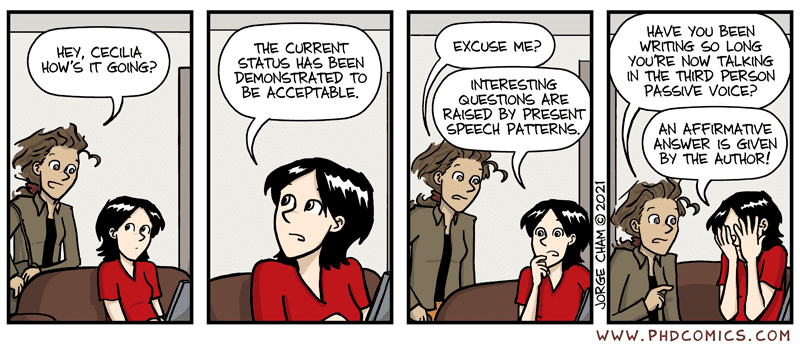
#2. Lab Safety
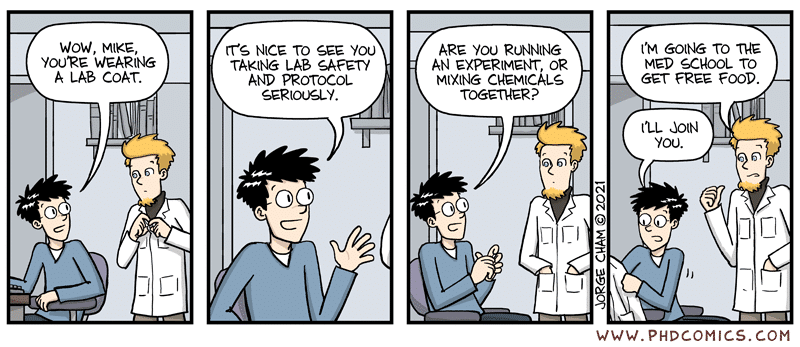
#3. Manuscript
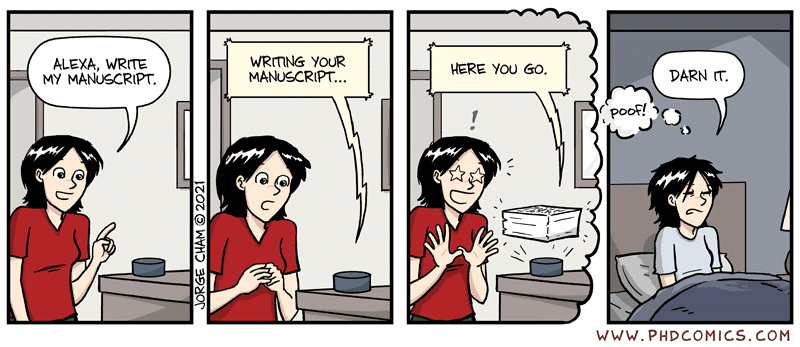
#4. Academic edition
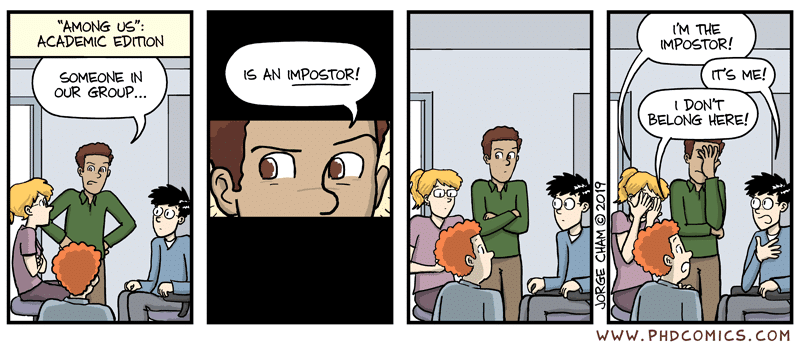
#5. Academic conclusions
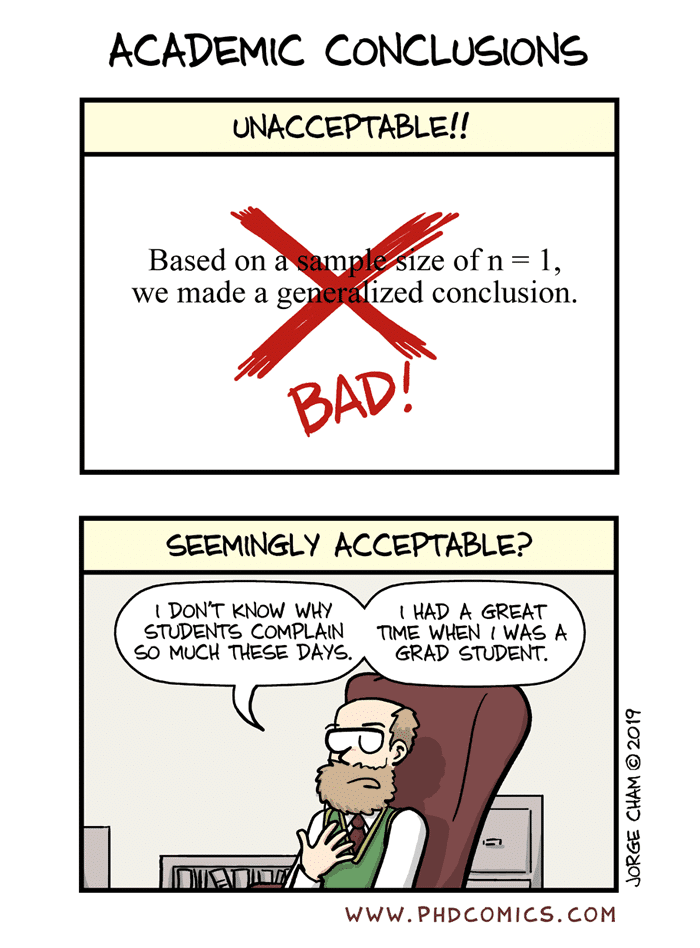
PHD Comics, also known as Piled Higher and Deeper , is a web comic strip written and drawn by Jorge Cham . It follows the lives of several graduate students as they navigate the challenges of academia. The comic is known for its humor, insight, and relatability. PHD Comics was launched in 1997 and has quickly become a favorite among graduate students and academics alike. The comic has won numerous awards, including the Web Cartoonists’ Choice Award for Outstanding Comic Strip. He has a strong online presence through their website and Instagram account, where he has an audience of 234,000 followers.
#6. Vacations
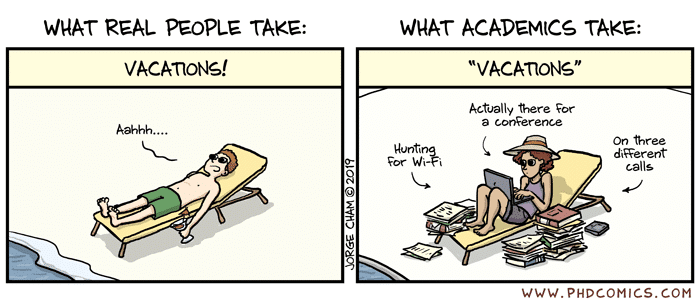
#7. Posting on Instagram
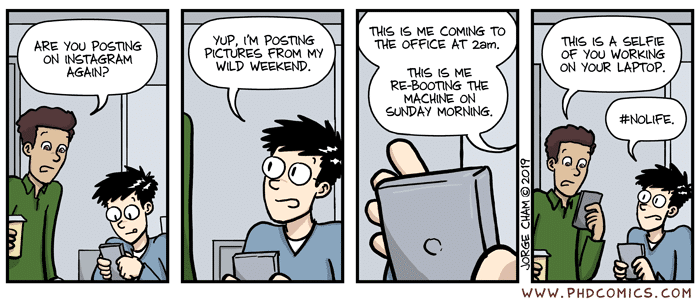
#8. Lifestyle Influencer
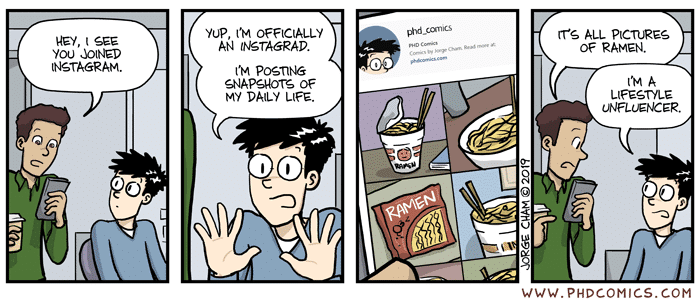
#9. Different Nightmares
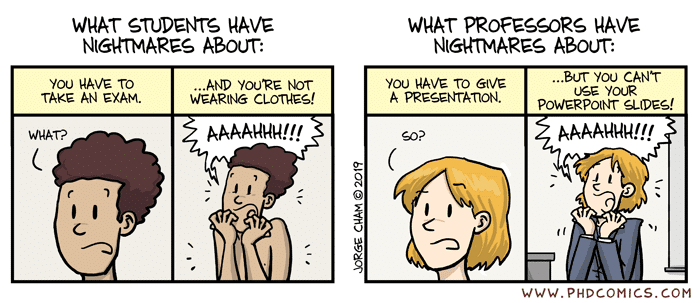
#10. Personal Projects
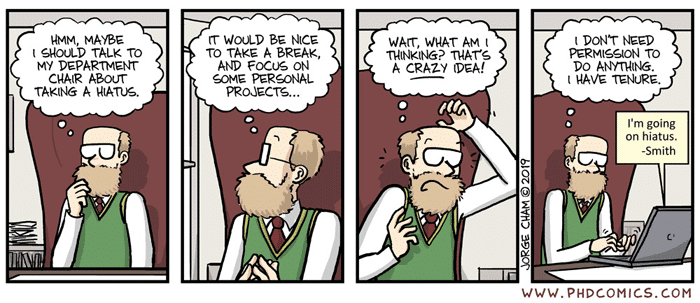
#11. Drawing
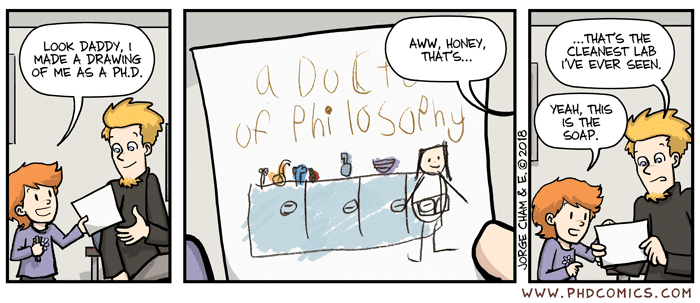
The comics humorously depict the everyday struggles, challenges, and quirks of life in academia. They often touch on topics such as research, teaching, publishing, conferences, and the academic job market. The series features a set of recurring characters, each representing different facets of the academic world, including the graduate student, the advisor, and the postdoctoral researcher. These characters are relatable to anyone who has been through or is currently in academia. Jorge Cham’s art style is simple and distinctive, making the comics easy to recognize. The characters often have exaggerated features and facial expressions, adding to the humor.
#12. Social media
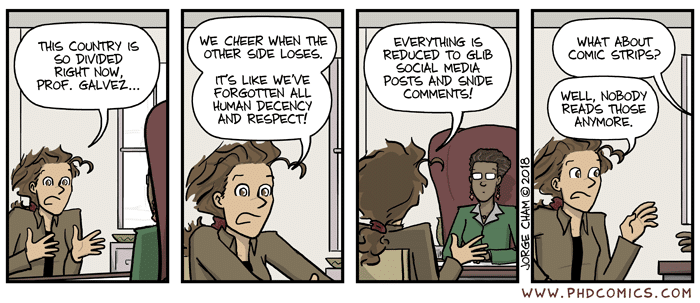
#13. What about research?
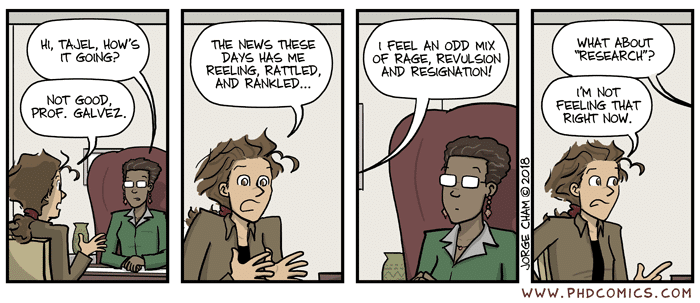
#14. That’s a valid career goal
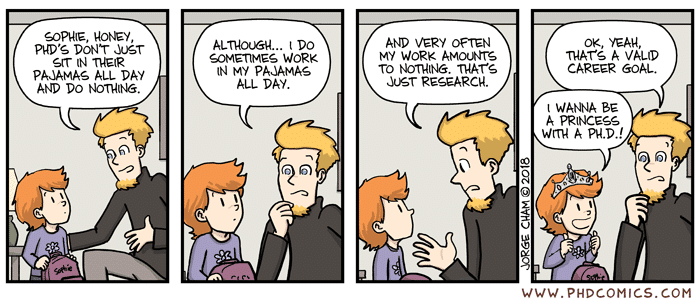
#15. What’s this?
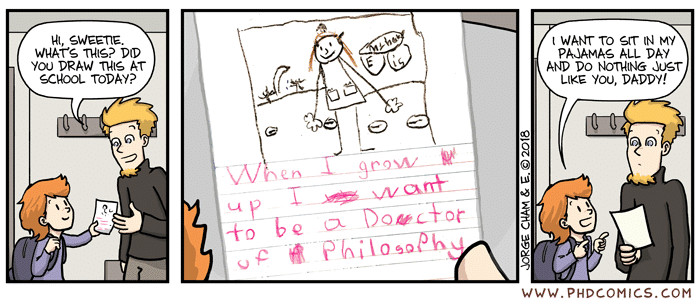
#16. Google is bestfriend
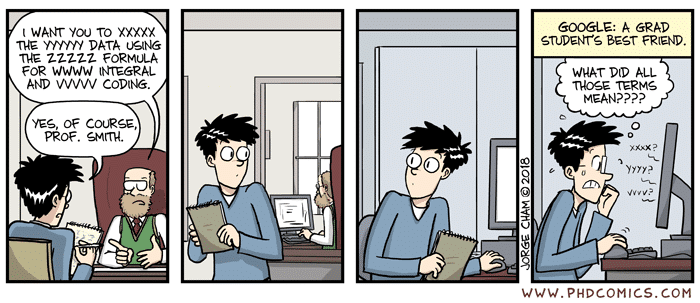
Cham experienced firsthand the trials and tribulations of graduate school, including the long hours, intense research demands, and the emotional rollercoaster that often accompanies doctoral studies. He found that humor was an effective way to deal with the stress and challenges. Creating the webcomic served as a form of catharsis for Cham. By turning his experiences into humorous and relatable comic strips, he was able to share his frustrations and triumphs with others who were going through similar experiences. This allowed him to find humor in the often absurd world of academia.
#17. Different Views
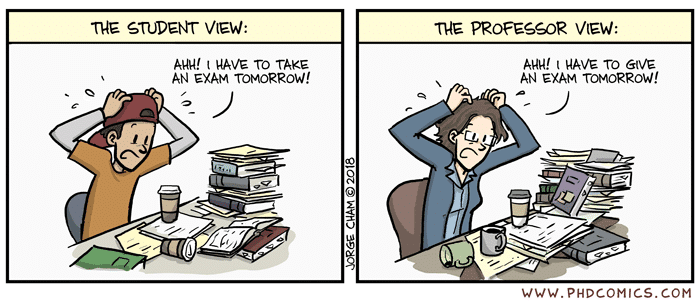
#18. There’s a conference
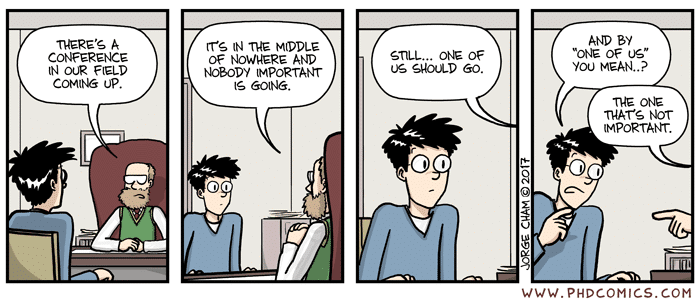
#19. Can’t Avoid
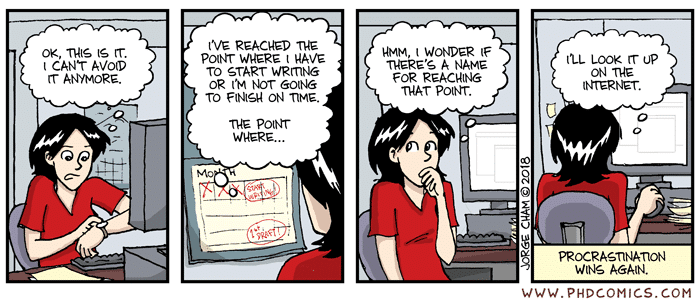
#20. Still Dreaming
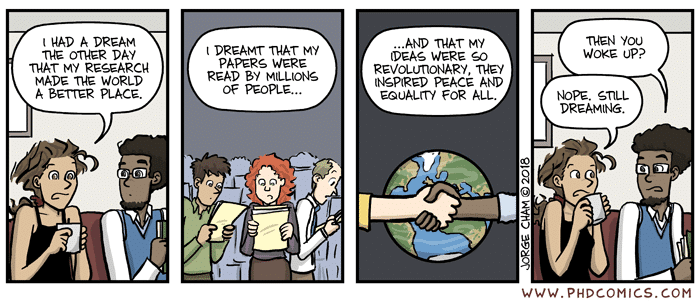
Share your love
Related posts.
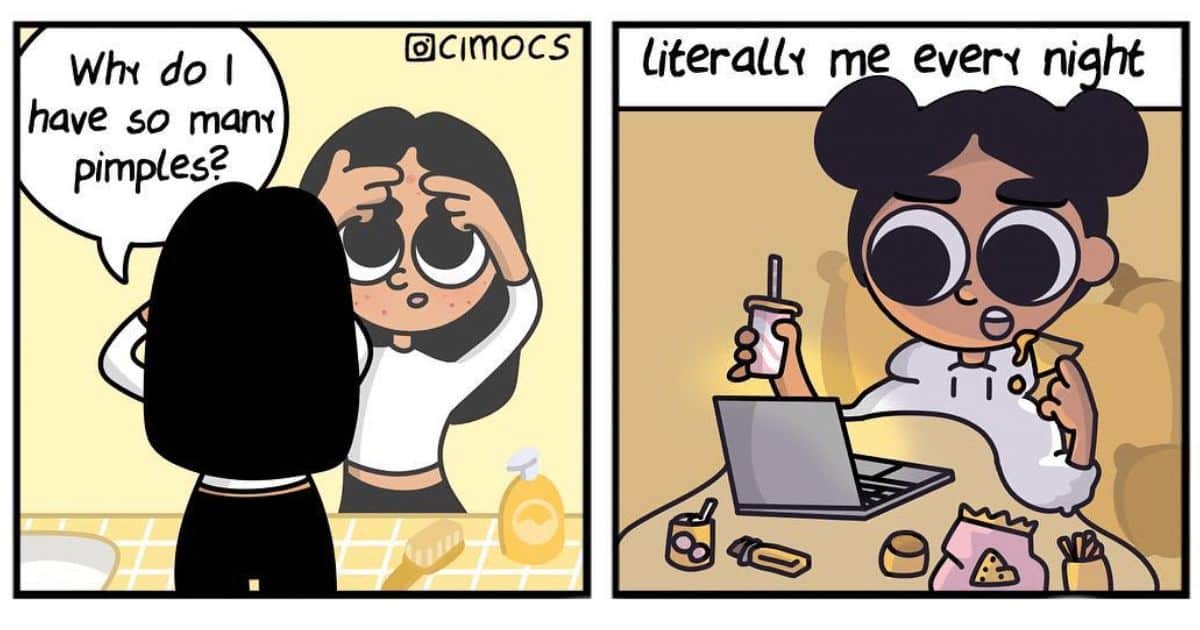
20 Cimocs Comics Perfectly Sums Up Moments Happening With Girls
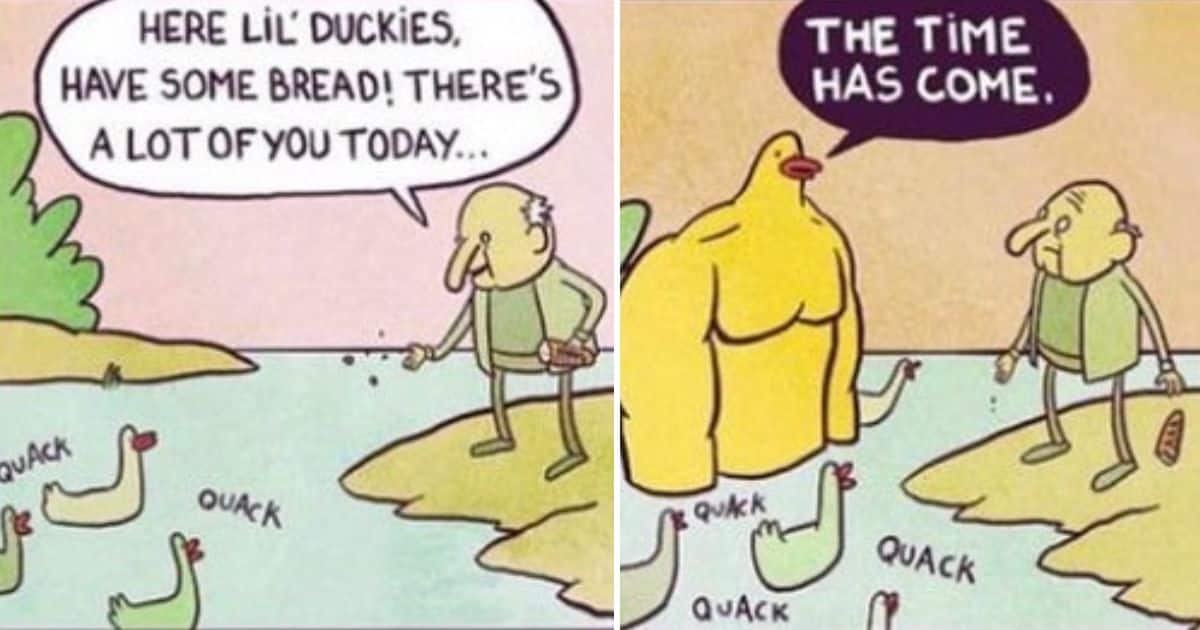
20 Pierre Mortel Comics Based on Dark Humor and Horror Situations
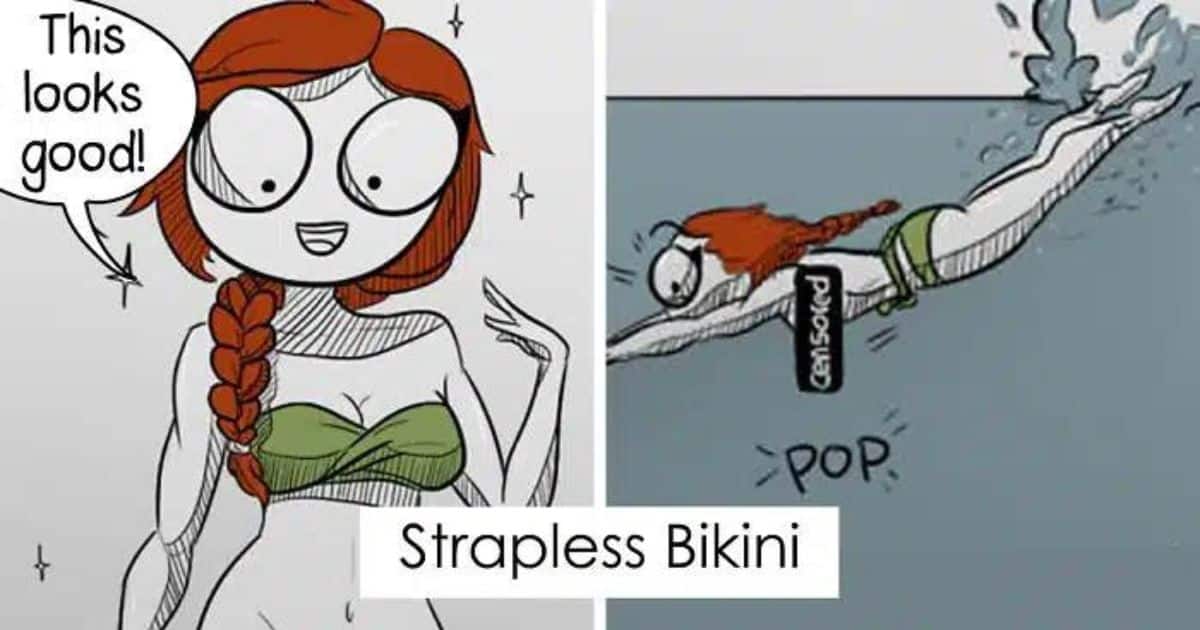
a medical student who did not dare to become a comedian, but finally got the courage (20 comics)
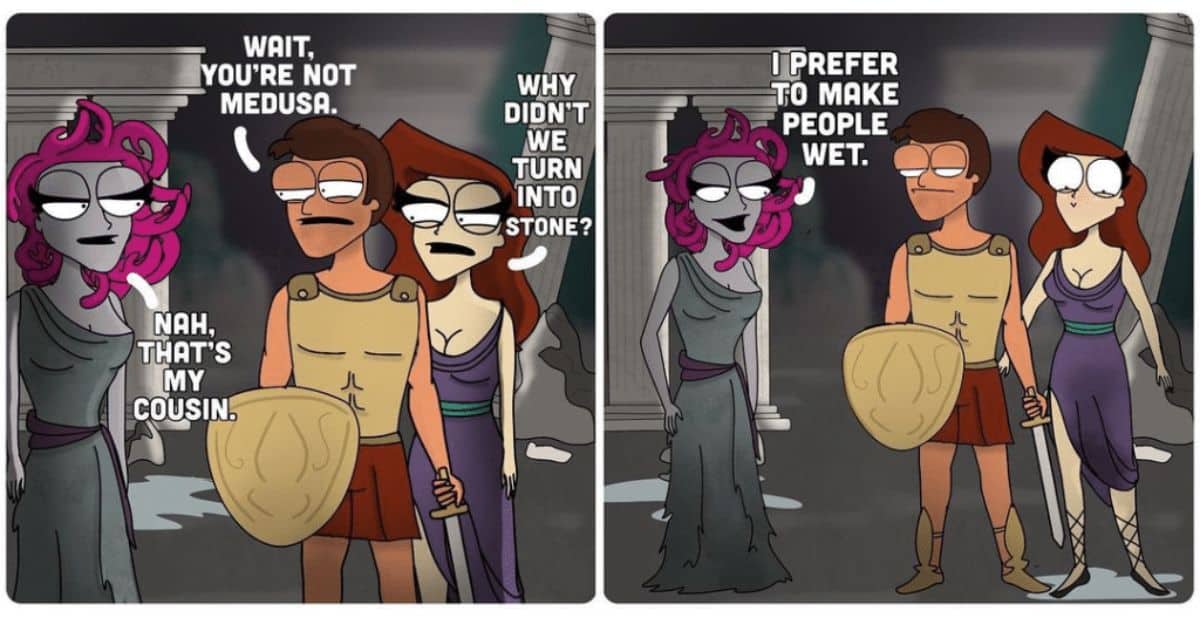
Kim Winder Depicts Humorous and Often Irreverent Takes on Everyday Situations (20 Comics)
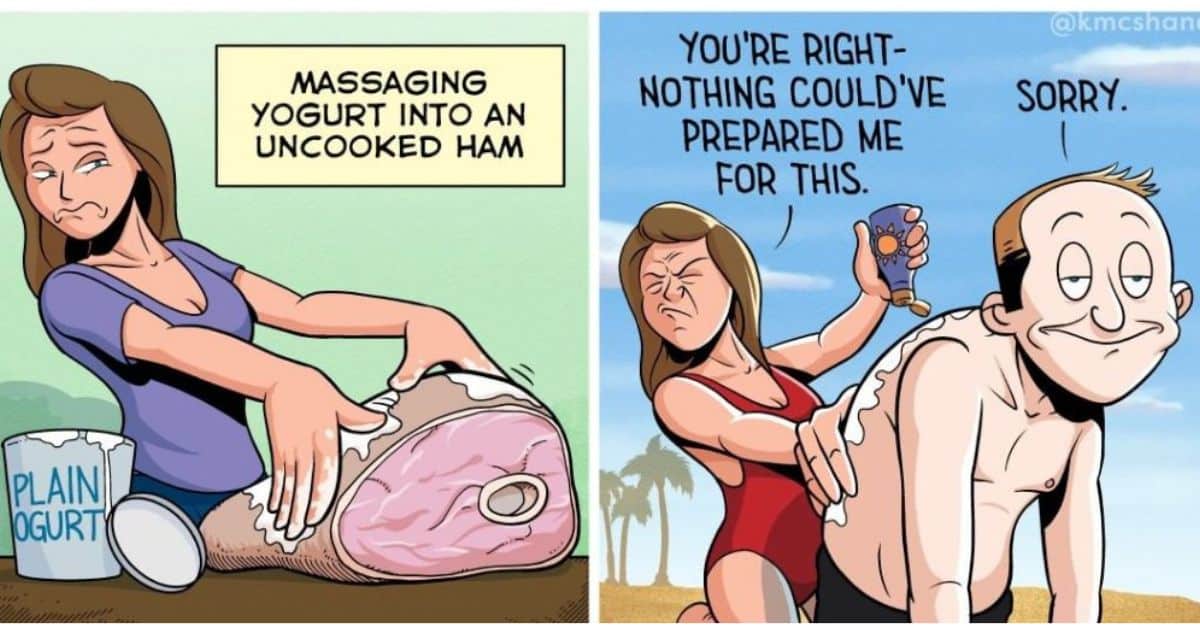
10+ Kevin McShane Comics Hilarious and Enjoyable Comics
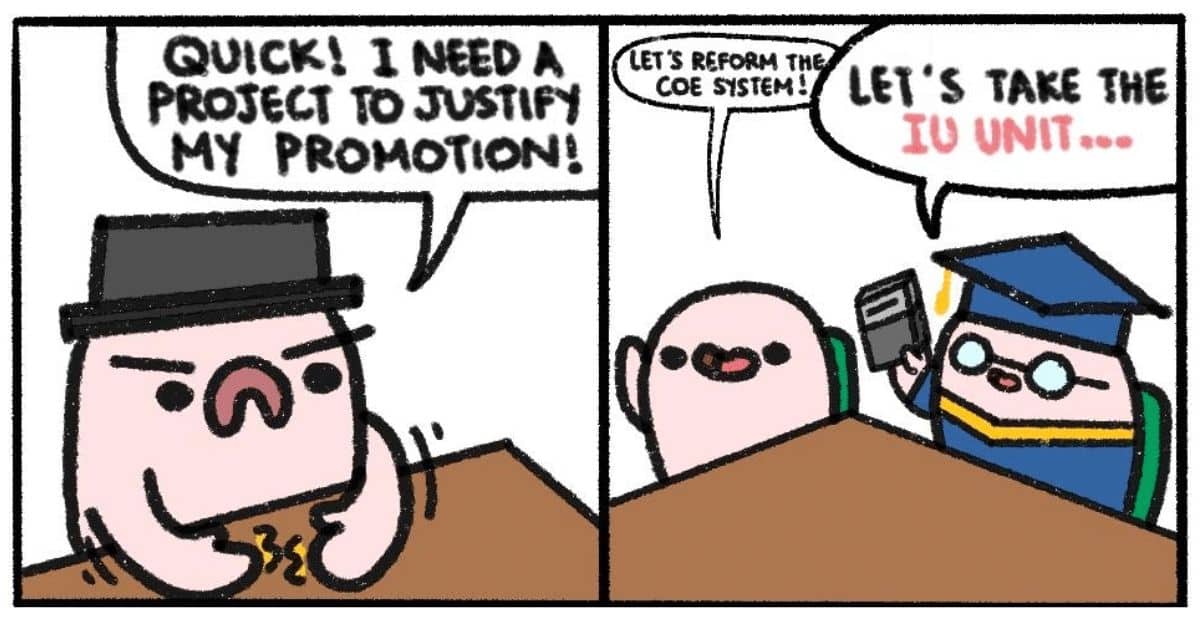
20 How to Eat Snake Comics Based on Random Moments in Daily Life
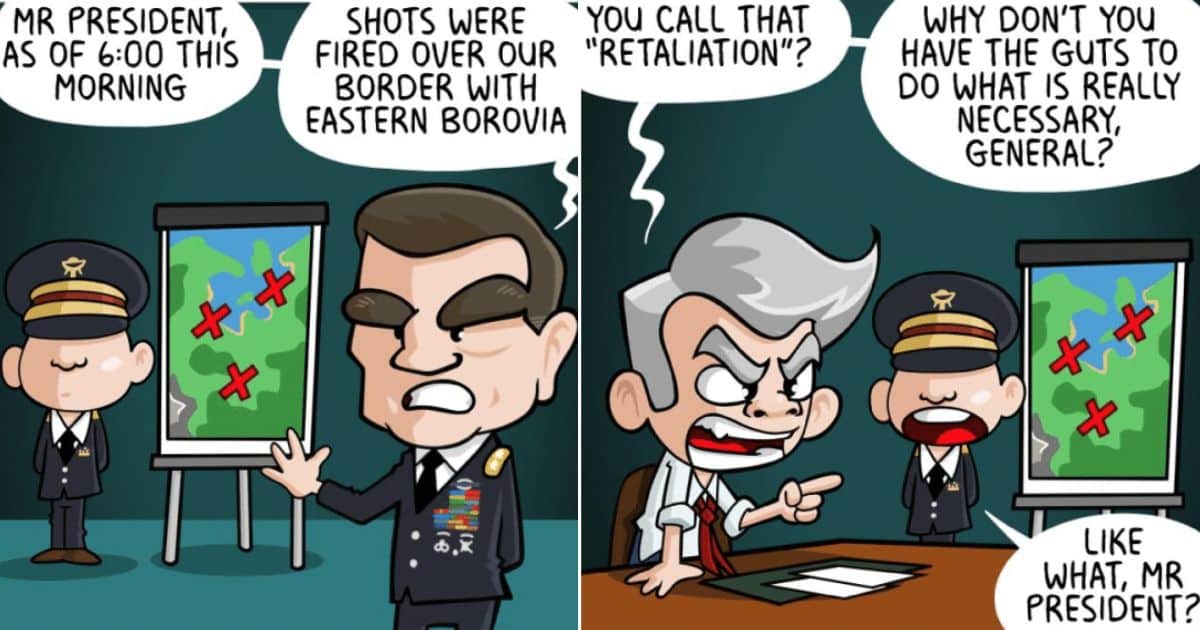
20 Ugly Sweater Comics Sums Up Hilarious Jokes To make You Laugh Out Loud
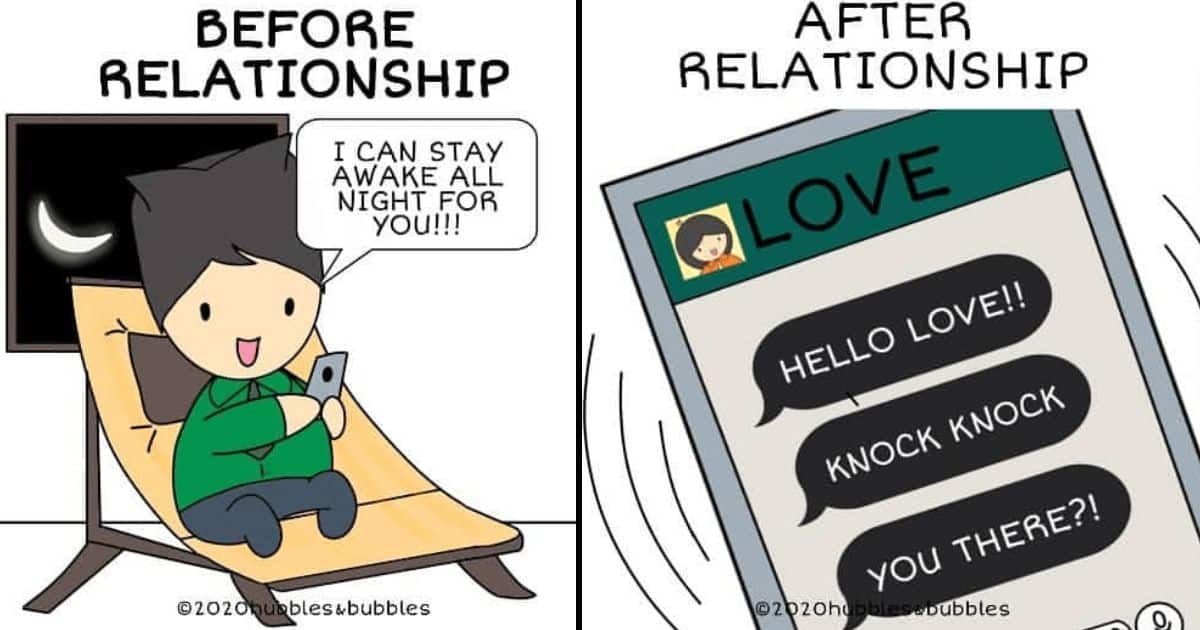
Hubbles & Bubbles Comics Based on Couple Everyday Life Moments (34 Drawings)
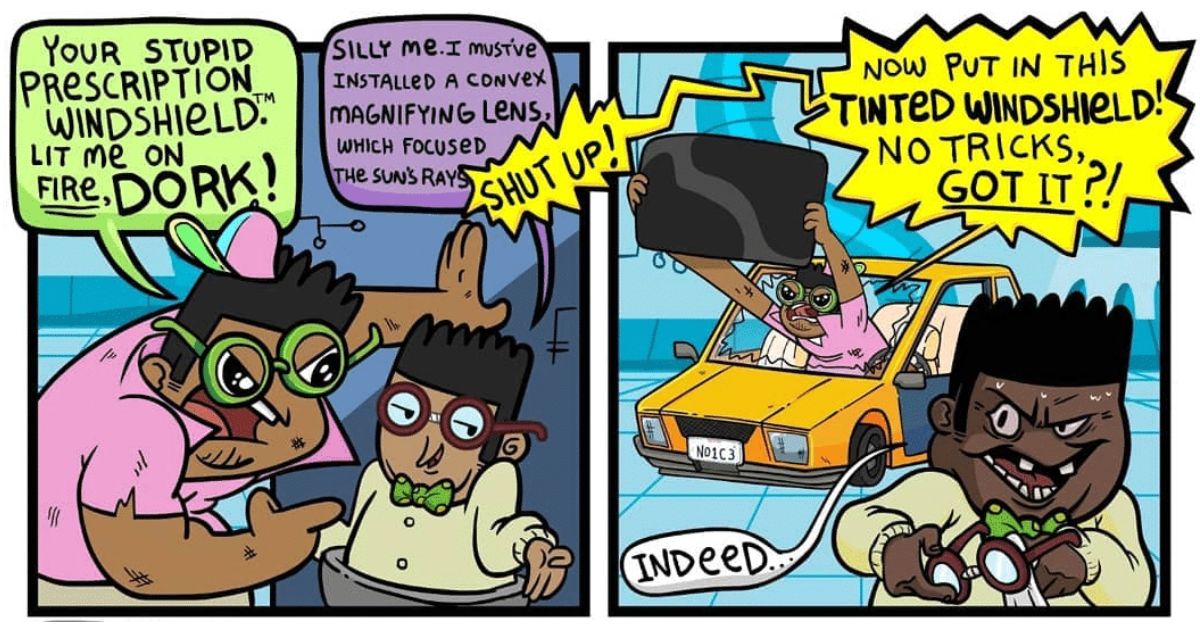
20 Bigfoot Justice Comics Based on Surprising Jokes and Dark Humor
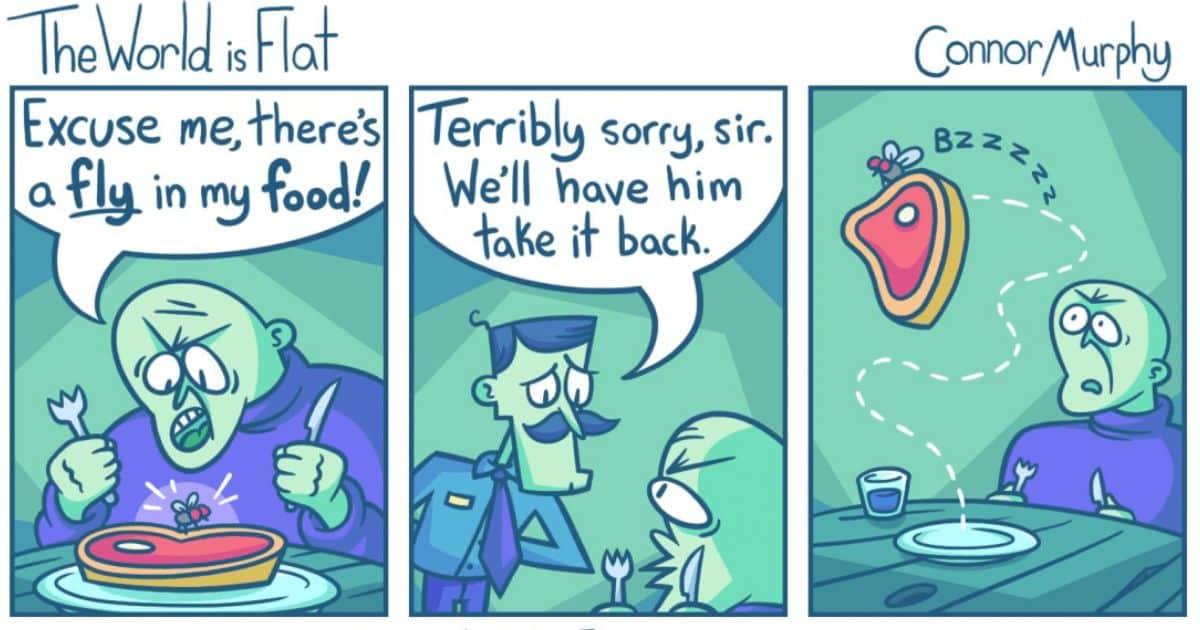
20 Times Cartoonist Connor Murphy Creates Hilarious Comics to Laugh You
About the author.
shahzaib ali
Leave a comment cancel reply.
Your email address will not be published. Required fields are marked *
Save my name, email, and website in this browser for the next time I comment.
What grad students are saying " Seriously, your comic is the only thing that keeps the Daily worth reading. I worship at your shrine of academic hilarity ." -A reader from Stanford U.
" To the creators of the amazing phenomenon known as P.H.D.--I am enthralled! You have captured the life SO perfectly! " -A reader from U. of Delaware
" Thank you so much for Piled Higher and Deeper. Bluntly, it is hilarious! I am sure that generations of undergrads will appreciate their newfound understanding of both their TAs and those even more mysterious RAs. " -A reader from the U. of Washington
" I really enjoy P.H.D.--the observations about life in grad school are right on, and I often laugh out loud when reading the strip. Thanks for making grad school a little easier. " -A reader from U. Michigan
" This is one of the best things I've seen in a long time! Thanks for giving my graduate studies' lack of purpose a bright side ." -A reader from U. of Florida
" Oh God, it hurts! It's all so true, and so evil! I can't tell whether I should be laughing or crying in sympathy ." -A reader from Caltech
" Piled Higher and Deeper is much cleverer, more artistic, and more original than most of the tired comics in the paper have been for years! Keep up the good work !" -A reader from U. of Arizona
- Show Spoilers
- Night Vision
- Sticky Header
- Highlight Links

Follow TV Tropes
http://tvtropes.org/pmwiki/pmwiki.php/WebComic/PhD
Webcomic / PHD
Edit locked.
The comics depict the typical life of graduate students in Stanford University: how they obsess about ever getting their theses completed, struggle to make ends meet with their meager stipends, wonder why life is passing them by, and slack off while their supervisors aren't looking.
Contains examples of:
- Absent-Minded Professor : Almost all of the Research Advisors introduced. They can barely remember the students' name, and hardly ever bother to read their thesis draft.
- Adaptation Name Change : Cecelia's advisor Professor Jones is named Professor Chu in the movies.
- All Issues Are Political Issues : Tajel often carries protest signboards for various causes.
- Ambiguously Brown : Dee's friend has a dark skin, but he has no name or distinctive features to determine his actual race (unlike Tajel, who we know is half-Indian from her mother).
- Batman Gambit : During Cecelia's thesis defense in the second film, her advisor Professor Chu gets an adversarial committee member to endorse her thesis by agreeing with him that an additional year of work is needed, knowing that he will change his mind to be Commander Contrarian .
- Bread, Eggs, Breaded Eggs : The "How You Spend Your Time" pie chart has a Sports & Leisure section which consist of surfing the internet, doing sports, and reading about sports while surfing the Internet.
- Call-Back : Mike teaches the protagonist how to distract with graphs, which unfortunately doesn't work too well for him. Mike himself does it over a year later, with more success.
- When we see Tajel interact with Prof. Rivera for the first time, he was lamenting her lack of apparent seriousness in her studies, especially when she chose to write about "The Grad student of Academia" for her research topic. Nowadays, their dynamics are reversed, as Rivera becomes the most egregious example of Absent-Minded Professor who never reads Tajel's draft and gives her useless advice, while Tajel desperately tries to get his support in writing her thesis.
- Professor Smith changed too. Originally he was The Faceless , then started to become more of an Absent-Minded Professor who tries to blend in with the students despite being clueless of their trends. Later, he just became a professor with a serious Lack of Empathy .
- Chekhov's Gunman : Early in the second movie, Allison points out Dr. Dukosky as the founder of their field, but the latter is surrounded by other conference attendees at the time and cannot be seen. Later during conference presentations, the Nameless Hero has a casual conversation with an old lady who turns out to be Dr. Dukosky, and she provides him with helpful advice in a subsequent scene.
- Child Prodigy : Professor Jones's daughter is only a first year in elementary school, but is intelligent enough to fix Mike's research data.
- Comic-Book Time : Every year, the strip features the characters celebrating birthdays, summer vacations and various holidays, but despite their constant complains that they're never graduating, they never seem to actually age. Cecelia lampshades this in one of her birthday strips, in which she decided that the time she spends in grad school doesn't count to her age, because it's basically living in a vacuum.
- Cool Old Lady : The second movie has Dr. Dukosky, the highly respected founder of the Nameless Hero's field of study, who takes the time to strike up a friendly conversation with him and offers him advice.
- Scott all but disappeared from the storyline after he broke up with Cecilia.
- Played for Laughs with Gerard, the token Humanities student, who was told by the PHD Comics management that he should either change his major or leave the comics altogether. He was then forced to attend a hearing to justify his existence, and had not appeared ever since.
- Creative Closing Credits : The first film overlays the credits on top of academic paperwork, accompanied by sketches of the cast and crew in the art style of the comics.
- Cuteness Overload : Most of the campus faculty practically melts at the sight of Mike's baby daughter, Sophy. He exploits this to distract them while he steals food from associations he doesn't belong to.
- Demoted to Extra : In the first film, Mike and Tajel were important supporting characters who gave guidance to the Nameless Hero and Cecelia respectively. In the second film, their roles are diminished, only getting some token lines and scenes that for most part don't directly affect the main plot.
- Divergent Character Evolution : In the earlier strips , all the University professors were portrayed as a collective group of sinister, faceless Hive Mind who goes out their way to make the students' lives more difficult, especially during Quals. Now, they're mostly given distinct appearance and personalities: Professor Smith is still the mean Stern Teacher , Professor Jones tries to be helpful but is often scatterbrained, Professor Rivera is very flippant and easygoing, but doesn't really pay attention to what his students are doing.
- Education Through Pyrotechnics : The machines used for experimental research frequently blow up in people's faces.
- The Faceless : Most of the research advisors don't get drawn in the comic panels, at least in the earlier strips. No longer the case since the 2003 strips.
- Failure Is the Only Option : To keep going, the series needs the characters to remain grad students, meaning they have to postpone the completion of their respective theses indefinitely. Mike ultimately subverts this; having been the oldest grad student for several years, he finally manages to finish his dissertation after years of procrastination and graduate, but stays anyway as a member of the teaching staff.
- Fourth-Wall Observer : Tajel takes this role in the movies. She addresses the audience at the end of both films, and refers to herself as a "secondary character" in the first movie.
- Gag Series : The main point of the strips are to make jokes about the life (or lack thereof) of a grad student, and make fun of the research advisors and Academia in general. When the strips go for more detailed plot and character development, some readers actually complain.
- Ignored Aesop : A Smithmas Carol ends with Smith reflecting on his life's journey and concluding with this: Prof. Smith: Eh, who cares? I've got tenure.
- Limited Wardrobe : Probably justified considering how cash-strapped the characters are. In any case, they are almost always depicted in the same outfits.
- Living Prop : Discussed in-universe regarding the status of grad students. Apparently, the faculty would be more likely to notice an actual missing furniture than they would a missing student.
- Meta Guy : Gerard, the Humanities student Recurring Character , only exists to represent another Grad School department apart from engineering. He's definitely aware of this, and most of his appearances have him address the readers in some way.
- Misery Poker : A humorous variation took place during the PhD widows meeting between Scott and Jenny as they ranted on their respective partners, Cecelia and Mike. Scott: Cecelia seems to have lost her way... She has a lot of work ethic but lacks purpose. Jennifer: My husband, on the other hand, has a baby on the way, but his work is pathetic and slacks on purpose.
- Misplaced Kindergarten Teacher : Cecelia's teaching style has shades of this in the first movie; she prepares baked goods for her students and comes up with an interpretive dance (complete with props and rhymes) to introduce the course material to them. She is eventually discouraged from doing this by the undergrads' seeming apathy, but returns to it enthusiastically once she gets out of her funk.
- Named by the Adaptation : In the movies, the Nameless Grad Student's name is given as Winston.
- Obstructive Bureaucrat : Faced by Mike when submitting his thesis (he has to come back because the layout isn't in perfect conformity with university rules), by Tajel when applying for a visa, and by the main character when trying to get reimbursed for travel.
- Promoted to Love Interest : The second film pairs up Cecelia and Winston (the Nameless Grad Student), though this is only revealed to the audience at the end .
- Recurring Character : Scott. He's Cecelia's boyfriend, but since he's not a Stanford student, he is actually featured less frequently than the nameless Living Props that are the Engineering Grad students. Lampshaded by Tajel when he suddenly shows up after a long absence. "Scott? I feel I haven't seen him in years
- Relationship Reveal : Throughout the second film, Cecelia and Winston (the Nameless Grad Student) are both shown receiving texts from an unrevealed party. It is revealed at the end that they had been texting each other and are romantically involved, following a Ship Tease at the end of the first film .
- Rhymes on a Dime : A lot of the comics' punchlines come from characters bantering with each other in rhymes. One example is the Misery Poker mentioned earlier, and another is the following exchange between Cecelia and her advisor. Cecelia: I have to reference... without deference? Prof. Jones: That's the preference.
- Rhyming Title : Several strips have titles such as "Webcam Labcam" and "What is... a Thesis?"
- Right in Front of Me : Upon meeting Khumalo, Tajel starts chatting him up without realizing that he's her new professor.
- Running Gag : π/2
- Sequel Hook : Near the end of the first film, Mike learns that his wife is pregnant. A sketch of their baby daughter is shown in the end credits, with "Sequel!" written next to her. She does end up appearing in the second film, though only for a brief moment in the opening montage.
- Skewed Priorities : Mike can remember "important stuffs" like who is the colorist for a particular X-Men issue, but forgets to take Quals, which he needed to graduate.
- The Slacker : While several characters are slackers to some extent, Mike Slackenerny stands head and shoulders above the rest in this regard. An eternal student, he's the PhD answer to Doonesbury 's Zonker Harris.
- She also accidentally spurts her drink on Scott when the latter mentioned that he had a job offer in London.
- Starving Student : All of the students, who live off instant ramen, and spend a lot of their time scavenging for free food.
- Mike finally graduated from his Ph.D, but he continues to stick around the campus as a Post-Doc whose activities mostly involve sleeping, napping and scavenging for free food.
- Prof. Rivera left Stanford for a position in another University, but continues to serve as Tajel's adviser. Since he barely communicate with his student or give her useful advice anyway, his departure has no virtually effect to her thesis.
- Still Got It : Prof. Smith when he finds out he can still take a nap balanced on a chair, as he used to do as a grad student.
- Though the supposed take that at Mythbusters makes it abundantly clear that he's never actually watched it and doesn't think about what the actual purpose of the show is (not to prove that something always happens, but to prove if it could happen somehow).
- Two Scenes, One Dialogue : In both films, there's a scene in which Cecelia and the Nameless Grad Student receive the same advice simultaneously from different parties at a pivotal moment. In the first film, the advice is respectively given by Tajel and Mike. In the second, it's given by the emeritus professor on Cecelia's thesis committee and Dr. Dukosky.
- Vague Age : No one really knows how old any of the characters are, since most of them are grad students who have spent countless of years in their program and not showing any signs of graduating soon, despite their constant lament that they're getting older and older as the years goes by. And given that Mike's baby daughter visibly ages over time, the setting probably doesn't run on Comic-Book Time .
- PhD - Episode 1 is based on The Phantom Menace .
- What is... The Thesis? is from The Matrix .
- Raiders of the lost dissertation is Raiders of the Lost Ark .
- Yank the Dog's Chain : During the credits of the second movie, a montage is shown of Mike's attempts to land an industry job during the conference. He is eventually offered a position... only for the employer to retract the offer when Mike starts gratuitously celebrating on the spot.
Alternative Title(s): Piled Higher And Deeper , Piled High And Deeper
- Webcomics Long-Runners
- Sluggy Freelance
- Ojisan And Marshmallow
- Rooster Teeth Comics
- Penny and Aggie
- School Stories
- Rain (2010)
- Slice-of-Life Webcomics
- Pixie and Brutus
- Short Titles
- Aroused by Their Voice
- ImageSource/Webcomics
- Eating Lunch Alone
Important Links
- Action Adventure
- Commercials
- Crime & Punishment
- Professional Wrestling
- Speculative Fiction
- Sports Story
- Animation (Western)
- Music And Sound Effects
- Print Media
- Sequential Art
- Tabletop Games
- Applied Phlebotinum
- Characterization
- Characters As Device
- Narrative Devices
- British Telly
- The Contributors
- Creator Speak
- Derivative Works
- Laws And Formulas
- Show Business
- Split Personality
- Truth And Lies
- Truth In Television
- Fate And Prophecy
- Edit Reasons
- Isolated Pages
- Images List
- Recent Videos
- Crowner Activity
- Un-typed Pages
- Recent Page Type Changes
- Trope Entry
- Character Sheet
- Playing With
- Creating New Redirects
- Cross Wicking
- Tips for Editing
- Text Formatting Rules
- Handling Spoilers
- Administrivia
- Trope Repair Shop
- Image Pickin'
Advertisement:
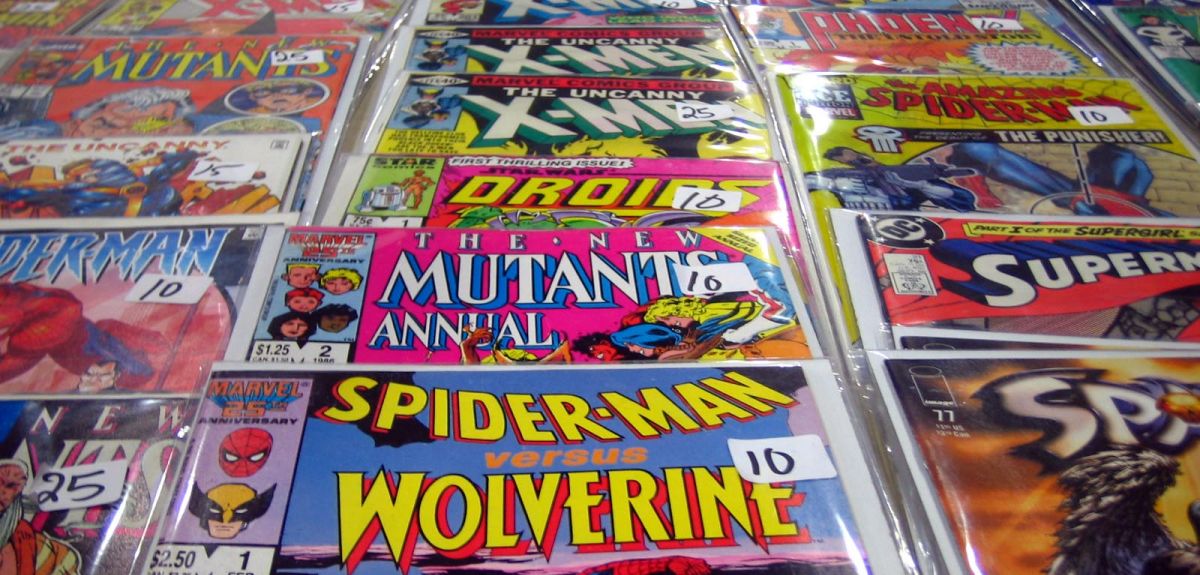
By Debbie R on Flickr, creative commons license
New research networks to study comics
A new research network about comics and graphic novels has been set up by The Oxford Centre for Research in the Humanities (TORCH).
Called ‘Comics and Graphic Novels: The Politics of Form’ , the network will look at questions like why comics are not deemed ‘academic’ and whether traditional critical approaches to literature can be applied to comics.
Dr Dominic Davies, a British Academic Postdoctoral Fellow in the English Faculty, has founded the network. He answers our questions about comics:
Have comics been overlooked in academia? Why do you think this might be?
Yes, comics definitely have been overlooked by many academics. This is in part because, by their very nature, they don’t fit easily into the disciplinary structures that we have today. Are they art? Of course, they certainly are, but because they’re usually collected together in strip or book form, circulated in newspapers or sold in bookshops, rather than hung in museums or galleries, it means they’ve often don’t get the attention of art historians and art theorists.
Conversely, are they literature? Many comics look like books, and there are lots of self-labelled comics short stories and ‘graphic novels’. They have a beginning, a middle and an end, and most of them contain text that drives the narrative forward. But they are, also, fundamentally, groupings of sequential images as well as words. The field of literary studies might have the tools to deconstruct comics’ narrative dimensions, but how can literary academics presume to analyse their visual materials? This is one reason that, in its early incarnations at least, comics studies has mostly been located in media studies departments, sometimes even film studies departments.
However, probably the real reason for the slow uptake of comics by academia is that comics have traditionally been seen as a ‘low’ cultural form, one that is filled with coarse language, silly jokes and subversive sentiments and thus not worthy of critical attention. This is especially the case when they are contrasted with the notion of literature, say, as a ‘high’ cultural form with moral worth. This division still haunts comics, even as they have been embraced by academics in recent years, and causes much self-reflexive debate. It was only with the publications of longer comics such as Art Spiegelman’s Maus, Harvey Pekar’s American Splendour, or Joe Sacco’s Palestine, which move away from conventional superhero stories and tackle complex and serious issues (Spiegelman’s comic is about his father’s time in Auschwitz, for example) that academia started to take them seriously.
So these longer, more obviously ‘serious’ comics, have gained the form recognition in academic circles, and even today academics still tend to focus on them.
Are comics taught in schools and universities? If not, should they be?
Comics mostly aren’t taught in schools. In the U.S., throughout the latter half of the twentieth century when comics production really began to surge, comics were seen not as a medium to help children with their studies, but as distractions—and definitely not something to be studied. This prejudice lingers in education syllabuses today. But there are always exceptions—a comic about anti-apartheid activism is read in schools in Cape Town to educate students about South Africa’s history, for example. And we are seeing comics-only modules cropping up in higher education now.
But this is in large part dependent on whether there is an academic in an English Literature department who happens to have an interest in comics, and the energy to build and offer these modules. One good example is Dr Paul Williams, who has set up a comics-only module at the University of Exeter, and who is coming to give a seminar at our TORCH Network.
As to whether or not comics should be taught in schools and universities, I think the answer is a resounding ‘yes’. The form is so rich, it does so many things that literature or art, as separate mediums, cannot. Indeed, in recent years, there’s been a surge in the kinds of stories that comics are being used to tell—there are now sub-genres within the field, such as autobiographics (autobiographical comics) and comics journalism—and in the popularity of comics, as more and more people find stories they can relate to.
Is there a difference between ‘comics’ and ‘graphic novels’?
That depends on who you ask. As comics have been deemed worthy of academic attention, the term ‘graphic novel’ has become more widely used. This is definitely related to the issue of ‘high’ and ‘low’ forms of culture I mentioned above. The term ‘comics’ is still associated with short strips in newspapers, or superheroes, and these still aren’t really taken seriously. The term ‘graphic novel’ has come to be used by academics to refer to the longer form comic, usually published all in one go as a book – and that is somehow a ‘higher’ cultural form.
It is the term ‘graphic novel’ that high street bookshops such as Waterstones and Blackwell’s use to categorise the comics they sell, and again I think this is related to the idea about what is ‘serious’ literature and worthy of being read by the kinds of people who frequent those stores. While the distinction between the terms ‘comic’ and ‘graphic novel’ has a certain usefulness, there’s a great deal of academic debate about its implicit politics. Graphic novels are still comics, and owe their existence to long histories and rich traditions that extend back into the twentieth century and earlier. Their relabelling as ‘graphic novels’ dismisses this history. Some critics even see the term as being cynically deployed just to make comics more palatable to middle class readerships, academics, and university English departments.
There are numerous other labels that can be used to describe the comics form. I prefer to use the term ‘long-form comics’ rather than ‘graphic novels’ when talking about book-length comics, because it means that we don’t forget the form’s long and valuable history. But it’s important to remember that even under the umbrella term ‘comics’ is a huge diversity of different kinds of reading experience, some of which bear little resemblance to one another.
Discussions around terminologies and definitions have always been at the centre of academic criticism on comics, and these debates are still ongoing, so there’s still no straightforward answer to this question. This Network will include seminars about ‘comics’ and ‘graphic novels’, but will remain self-aware and open to thinking about how these terms are used and what the implications of this usage might be.
Can you apply traditional critical theories to the comic form?
Comics can be analysed with the critical theories that art historians might use, or with other tools from the broader field of visual cultures, such as W.J.T. Mitchell’s work on ‘picture theory’. But since they’re also narratives, literary criticism’s numerous theories such as narratology and discourse, not to mention other fields such as feminist or postcolonial criticism, have a role to play here.
Though comics haven’t had the attention that they deserve from academia, the relatively few critics who have written monographs on them and, in the occasional case, devoted their entire careers to them, have come up with some really sophisticated theories specifically designed for reading comics.
And comics are inherently interdisciplinary, so the tools needed to read them are also interdisciplinary. So it’s really important that our network creates a space for conversations to take place across the traditional disciplinary divides. We’re trying to bring literary critics into dialogue with visual cultures scholars.
And given that the comics and graphic novels we’ll be discussing in the seminars cover such a range of topics, it’s also really important that we welcome historians, geographers, and politics students into the conversation as well. There are also comics being produced in a number of different languages, and so we have committee members from modern languages departments.
How can people get involved and what can we look forward to?
Because the history of comics criticism has always been practiced as much by artists themselves (Will Eisner, Scott McCloud) as it has by academics, we are going to alternate visiting academic speakers with visiting artists to learn more about how actual practitioners go about writing and drawing their comics. So in Michaelmas Term 2016, we have Dr Helen Iball from the University of Leeds talking about autobiographical comics, and Dr Charlotta Salmi from the University of Birmingham presenting some of her recent research on protest and graphic novels in the Middle East.
But we also have some artists coming to present their work and offer their reflections, such as Karrie Fransman, who did a TEDx talk on comics quite recently, and Samir Harb, a geography PhD student at the University of Manchester who is also a published comics artist.
The seminar will run every two weeks throughout term time, and each of these speakers and artists will circulate some comics for participants to read in advance. It’s really important that the Network gets people to actually start reading some comics as well as simply talking and hearing about them.
In addition to the bi-weekly seminars we’ll also have one-off events, in collaboration with other TORCH Networks or other seminar groups based at the university. For example, Jennifer Howell, author of The Algerian War in French-Language Comics (2015), is coming to give a one-off seminar in November 2016.
All will be welcome to attend any of the seminars and talks we’ll be putting on, and we’ll be advertising each event through TORCH, the English Faculty, and various other mailing lists and outlets. In addition, we are currently building up a mailing list of our own, to which you can subscribe by emailing [email protected] or [email protected] . We’ll also be active on social media, so people will soon be able to like us on Facebook and follow us on Twitter, and we’ll feature regular blog posts about comics-related topics on the TORCH website as well.
About Arts Blog
The latest news and views in the arts, humanities and culture at Oxford University. Curated by Sarah Whitebloom, Media Relations Manager (Research and Innovation).
Contact: Sarah Whitebloom, [email protected]
- Reference Manager
- Simple TEXT file

People also looked at
Community case study article, teaching science communication with comics for postgraduate students.

- 1 Départment de génie mécanique, Faculté de génie, Centre de Recherche Acoustique-Signal-Humain, Université de Sherbrooke, Sherbrooke, QC, Canada
- 2 Centre compétences recherche+, Université de Sherbrooke, Sherbrooke, QC, Canada
- 3 Département de biologie, Faculté des sciences, Université de Sherbrooke, Sherbrooke, QC, Canada
Data visualization and visual storytelling are increasingly common terms when institutions and scientists want to introduce people to their research and science through stories. Yet institutions mostly teach and train their scientists in the language of science and scientific journals, whereas research dissemination calls for other forms of communication. A new university course introducing such a new form of communication is proposed to postgraduate students at Université de Sherbrooke since January 2020. Its main objective is to help students develop their general interest and skills into science communication using comics as a working medium. While following a simple path, this course has generally led to results beyond initial expectations and large engagement from students. This study describes the general context and structure of the course, analyzes feedback from participants, presents some results, and summarizes lessons learned to help the diffusion of such a cross-disciplinary course.
1 Introduction
The great majority of scientific work is generated and communicated in the form of academic studies. Their yearly number has grown by a third since the beginning of the 21st century ( Wilsdon et al., 2011 ) and reached an estimated value of 1,500,000 studies in 2015 ( Unesco, 2015 ). This data deluge combined with the use of an arcane scientific language limits the impact and awareness of scientific discoveries to a narrow and specialized audience. It also raises questions about how a scientific study is currently presented and/or written and how scientific information can be communicated to diverse users in diverse ways ( Sopinka et al., 2020 ). Increasingly, authors and publishers look to including non-traditional or additional research artifacts in publications so as to enhance interactions. The Acta Acustica journal recently launched “Audio Articles,” a type of scientific article with embedded audio files in the PDF and HTML versions of the article. Reactive and interactive diagrams are also proposed in digital publishing, and graphical abstracts are becoming ubiquitous ( Nature Chemistry, 2011 ).
In this context of a fast growing rate of science contents, the importance of science communication or research dissemination has increased for scientists and institutions to make research accessible to a wider audience but also to justify and stimulate funding ( Ross-Hellauer et al., 2020 ). As the progress in different fields of science increasingly impact our understanding of the world and the way it is governed, the scientific community faces the challenge of communicating in efficient, clear, and engaging ways findings that are ever more complex. Considering how many variables may have to be considered to give an accurate view of any given field, this is however not always readily feasible. To wit, a 2016 study evaluating successive summaries by the Intergovernmental Panel on Climate Change Summaries for Policy Makers determined that this extremely important document remained of low readability despite considerable efforts ( Barkemeyer et al., 2016 ). It is in this context of having to explain in more engaging ways concepts that are ever less easy to summarize that this project was instigated.
Ideal scientists should thus surely own a scientific language to interact with peers, but they should also develop abilities to communicate their science using compelling approaches such as different ways of telling stories. Indeed, storytelling/narratives are keywords that are often seen to describe a new practice for scientists to share their messages and findings in an engaging way ( Flemming et al., 2018 ; Green et al., 2018 ; Hoffmann, 2020 ). Combining storytelling and science is sometimes discussed ( Katz, 2013 ; Nature Methods, 2013 ) but is generally strongly advised to strengthen the interface between science and practice or between science and human beings ( Krzywinski and Cairo, 2013 ; Arevalo et al., 2020 ; Jones and Crow, 2020 ; Muindi et al., 2020 ). To coin a phrase, data makes a story more credible and a story makes data less boring. Scientists can be portrayed as individuals and their motivation for research can be made relatable, and using a narrative style in an article can even positively impact its citation rate ( Hillier et al., 2016 ). As a consequence, data-driven storytelling ( Riche et al., 2018 ) is becoming a field in its own right and showcases interactive visualizations for science communication and education. Arts, educational games 1 , entertainment, imagination, and creativity are finally being included into teaching and learning approaches ( Fahnert, 2019 ; Robin and Jaouen, 2019 ).
While having been the object of various criticisms ( Wertham, 1954 ) and considered to be a subliterature for a long time, comics are now a legitimate art form, the ninth art , and an academic discipline 2 along with its specialized journals (few examples are: SANE journal: Sequential Art Narrative in Education; Journal of Graphic Novels and Comics; and The Comics Grid: Journal of Comics Scholarship). The fact that comics can be recognized as a legitimate form of academic publication has been demonstrated by several authors ( Tisseron, 1975 , 2009 ; Hureau, 2019 ; Sousanis, 2015 ). Comics are also considered as a full-fledged tool for disseminating and explaining science. Since the 1940s ( Sones, 1944 ), comics have been generally seen as a valuable educational resource ( Morel et al., 2019 ; Scavone et al., 2019 ; Kirtley et al., 2020 ) and science comics are now highly common ( Schultz et al., 2009 ; Doxiadis et al., 2009 ; Hosler, 2013 ; Harder, 2015 ). Initiatives linking comics and science dissemination are mushrooming, including specialized websites 3 , cooperations 4 , and specialized meetings (Telling science–drawing science 5 ). A comic book presenting the study of ten doctoral students and drawn by professionals cartoonists has been published for the five last editions of the annual French national science fair, reaching 80,000 copies in 2019. The European research council launched the “ERCcOMICS” initiative 6 in 2014 that aims to circulate web comics promoting and explaining the achievements of 18 funded European research projects. More and more researchers advocate a larger use of comics in science ( Farinella, 2018a , b , c ; Scavone et al., 2019 ). One current trend is designated by the compound and new term “data comics” ( Zhao et al., 2015 ; Bach et al., 2017 ; Wang et al., 2019a , b ), which is praised for teaching data visualization and storytelling. Data comics can even help to humanize data for complex topics, typically related to health ( McNicol, 2016 ; Alamalhodaei et al., 2020 ). Examples of graphical abstracts taking a comic-like form are becoming common ( Caudron and Barral, 2013 ; Poisson et al., 2020 ). Creating comics is generally found to have a positive effect on students ( Scavone et al., 2019 ) and comics–science workshops are more and more being evaluated for younger people ( Tatalovic, 2009 ; Hosler and Boomer, 2011 ; Spiegel et al., 2013 ; de Hosson et al., 2018 ) or undergraduate students with a background in arts ( Wang et al., 2019a ). While guidelines or instructions for using this medium are now provided in the form of academic works ( Friesen et al., 2018 ; McDermott et al., 2018 ), concrete initiatives to train graduate and postgraduate students to the use of comics in their research project remain scarce. All these initiatives are mostly held by external facilitators ( de Hosson et al., 2018 ) and rarely by academic institutions.
While these observations show that comics are increasingly accepted as a valid, versatile, and engaging teaching resource, a significant hurdle in their widespread adoption is that relatively few people consider themselves to be sufficiently skilled artistically to consider producing their own; as with any field requiring a certain technical expertise, the first step might appear a little daunting. Here, we hypothesize that independent of a communicator’s artistic skills or prior familiarity with comics, it is possible to devise a very focused course introducing science communicators to the basics of comics’ grammar and to provide the technical skills required for even a neophyte to create comics of high quality.
Such a course has been devised as part of a global program to develop postgraduate students’ transdisciplinary skills and has been offered since January 2020 at Université de Sherbrooke (EFD919-Communication scientifique par la bande dessinée/Science communication with comics, two academic credits). The course has currently been given on four distinct semesters. Since it is offered to any faculty of school of the university, participants profiles generally include a broad range of specialties (examples are engineering, natural sciences, health studies, biology, quantum mechanics, education, management, and law). While the course only includes 12 h of traditional teaching, the involvement of students and the results obtained generally exceed all expectations. Self-assessment of participants furthermore indicate a strong confirmation of our hypothesis, as a vast majority of responders reported an important or very important progress in their science communication skills and their confidence in using comics for science communication.
So as to share this experience, this communication describes the global methodology used for the course including setup, organization, and assignments. The benefits for participants in terms of science communication are analyzed using surveys. Lessons learned and future directions of this course are finally discussed, together with the possible uses for student’s works.
2.1 Course Organization and Attendance
The EFD919 course was given during Winter 2020 (W20), Summer 2020 (S20), Winter 2021 (W21), and Summer 2021 (S21) semesters. The three objectives of the course are 1 ) to train researchers to science communication, 2 ) to help them develop transdisciplinary skills, and 3 ) to generate concrete contents for science communication. Over the four teaching sessions, 42 students followed and passed the course. Among them, 45% were women ( N = 19), 55% were men ( N = 23), and 74% were international students ( N = 31).
The two teachers have proven skills in comics and science communication and have designed the course materials and organization. It is composed of four workshops of 3 h long each, and each spaced by approximately 3 wk in order to allow sufficient time to elaborate and complete each intermediary work. The course was given in a classroom-based approach in Winter 2020 and Summer 2021 sessions and using an online teaching platform in Summer 2020 and Winter 2021 sessions given the COVID-19 pandemic. Even if this lowered the interactions level, the teachers did not notice a firm difference between classroom and online results.
For all the teaching sessions, the breakdown of the course was as follow:
• The first workshop integrates theoretical and general aspects concerning science communication, tools commonly used to disseminate content, and concrete examples of comics use within this area. The students are asked to write a summarized while popularized text concerning their research as a preliminary work (to be submitted prior the workshop, 300–400 words long). Each student introduces her/himself and has to summarize its research using popularized terms.
• The second workshop introduces the use of tools (free and open-source digital drawing software such as Krita, Medibang, or Inkscape). Comics grammar is also introduced (balloons, strips, and sketches), and examples of script breakdowns are discussed. Students briefly present their first breakdown of their scenario (popularized text transformed into a story) and then work in small groups (two to four people) to discuss/improve/elaborate their story. Teachers provide occasional interaction with groups for advices and suggestions.
• The third workshop first covers additional technical points like lettering, fonts, and balloons. Each participant presents his/her first drawn work and explains narrative choices to the group. This allows attendees to receive and provide comments and suggestions.
• The fourth workshop is fully devoted to the presentation of final works. Each comic is read publicly, and again all attendees are asked to receive and provide immediate reactions and comments.
Between workshops, the teachers provide individual feedback to all participants (concerning submitted intermediary works but also to answer to more specific questions, technical or general). To ensure inclusiveness, the workshops are systematically composed of several teaching and learning methods as well as varied educational content (lectures, multiple techniques, multimedia tools, and online videos). As pointed out in the course’s breakdown, each work is evaluated and discussed by the teachers but also by the other participants during the workshops. Joint work and group feedback provide source for emulation and sharing of ideas and help verify understanding of key messages. Completion of the course requires the submission of a final drawn work to be used in any context (article, scientific presentation, interactions with the general public, and individual development, see two examples in the Results section). The advised type of work is two-page comics to have sufficient space to describe a subject but also to limit the amount of work to be done. Two-page comics represent approximately two-thirds of final works. Depending on the chosen support and subject, other typical outputs are posters, one-page comics, or more-than-two-page comics (some students even expanded their work up to eight to nine pages).
2.2 Surveys
Data were collected from three online surveys administered through the Moodle learning management system. Attendees received an initial notification about the surveys from the course teachers, and then two recruitment emails, each 5 days apart approximately. It is precised that a generally larger number of answers was obtained for the pre-course survey, since some students that initially registered for the course did not finally attend (especially for W21 session). All answers were nevertheless kept. The pre-course survey was designed to take respondents 5 min to complete and assessed each participant expectations and background for the course using close-ended questions. This survey was only administered after the course has been taught for the first time (i.e. after W20 session), and thus three teaching sessions are considered. The two post-course surveys were designed to take respondents 10 min to complete. The first post-course survey assessed the course impacts in terms of earned experience and knowledge, using close-ended questions. The second post-course survey aimed at collecting information concerning the use of comics and its components within the frame of science communication, and from the students standpoint (how they used comics’ features and elements in their work?). The questions and possible answers for each survey and corresponding results are reported in the following section. The pretest survey return rate was 95% while the two post test surveys return rate was approximately 80% (S21 session had the lowest response rate).
3.1 Two Examples of Student Works
Figures 1 , 2 illustrate two typical work progressions as a function of the workshop number. Both students had hand sketching experience but were novices concerning comics and its design.
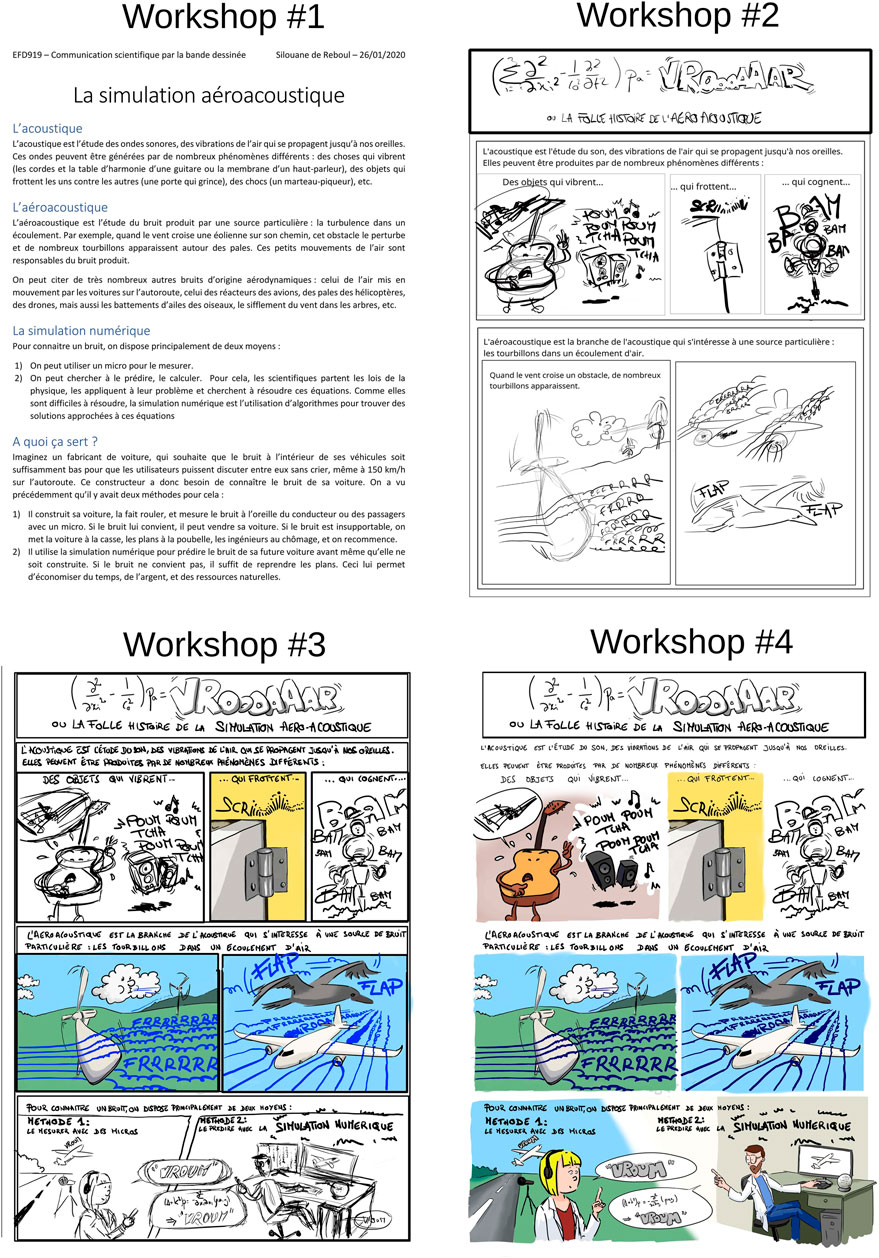
FIGURE 1 . First example of the course outcomes: Workshop #1: initial popularized text; Workshop #2: first graphical breakdown; Workshop #3: second graphical breakdown; Workshop #4: final colorized work (Silouane de Reboul, La simulation aéroacoustique - Aeroacoustics simulation ).
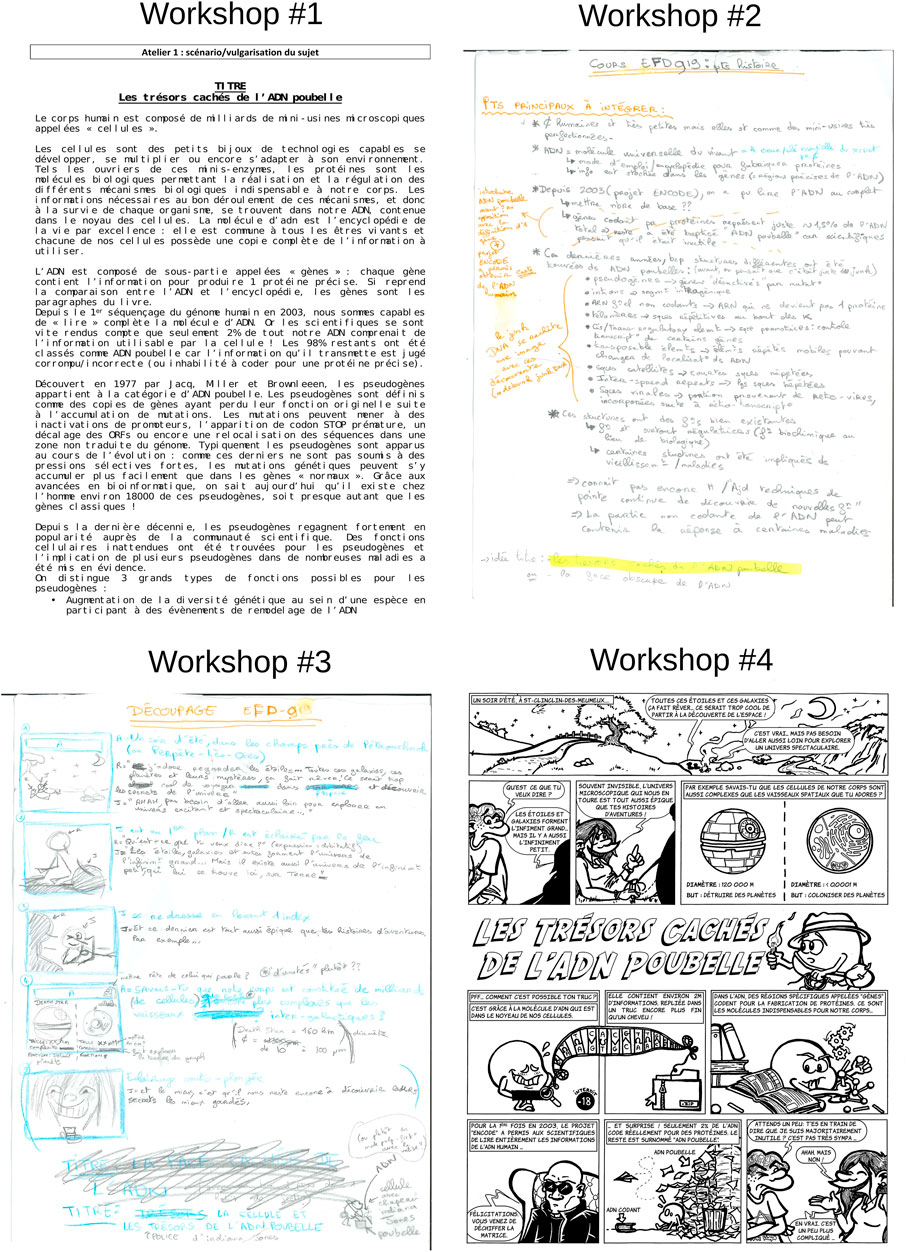
FIGURE 2 . Second example of the course outcomes: Workshop #1: initial popularized text; Workshop #2: first written scenario breakdown; Workshop #3: second scenario breakdown including sketches; Workshop #4: first page of the final black and white work, later colorized (Julie Frion, Les trésors de l’ADN poubelle - Junk DNA’s treasures ).
The compact nature of a short comic demands that the author first identify the core message that is to be carried out. This is done in a first rough script, in which elements will be considered and either retained or set aside, depending on how necessary they are, how they affect the flow of the story, and how much leeway the storytelling approach allows (see Figure 1 - Workshop # 1 and Figure 2 - Workshops # 1–3). Graphical elements can already be considered at this stage. In the second step ( Figure 1 , Workshop # 2), a rough draft allows the author to set the pace and tone of the story, determine what information can be fitted on the page, and see how it can be best integrated in the story line. This step usually leads to several alternate versions. The following steps ( Figure 1 , Workshop # 3–4, Figure 2 , Workshop # 4) actualize the ideas considered in the preceding step, with final adjustments being made to enhance the story’s pace and its readability. Fonts are adjusted, and complex words are replaced by synonyms or simpler wordings. Graphical analogies and metaphors are nearly always embedded into the work (Onomatopoeia in Figure 1 –Workshop # three to four, the Star Wars death star vs. our body cells to illustrate respective diameters and objectives in Figure 2 –Workshop # 4).
It can be precised that even if all works start with a popularized text and end with a piece of comic-based work, the followed path between these two points can vary between participants. This heavily depends on the creative part of the process, and the main idea of the story can be either found very soon or might take a longer time to be identified. It is not unusual that students do not present a first breakdown for the second workshop because they did not find their starting point. Presentations from other students and group works in Worshop # 2 usually help triggering this process.
3.2 Pre-course Survey
The results from this survey are provided in Table 1 . The general knowledge level concerning science communication, evaluated in Question 1, is nearly normally distributed around the median answer, with 54 % of answers. It appears from the results of Question 2 that the great majority of attendants consider that they have an overall very low or low level of knowledge concerning the use of comics for science communication (46 % “Very low” and 46 % “Low”). Nevertheless, the answer to Question 3 reveal that this is not necessary linked to a lack of confidence, with 68 % of the students reporting a “High” or “Very high” confidence level. Overall, the distribution of answers (from “Very low” to “Very high”) concerning knowledge and confidence are nearly opposite. According to Question 4, 68 % of the attendants think that science communication using comics is not common, and 20 % even report having never thought of it before. This shows that even if the use of comics is strongly developing as pointed out in the Introduction section, this use is not well known by postgraduate students. Finally, the results of Question 5 concerning students’ prior skills for this course show that a little more than half of students (57 % ) could be considered for beginners. From the students point-of-view, comic-based science communication is thus perceived as unknown as its tools and methods, but it nevertheless gives them confidence into its use.
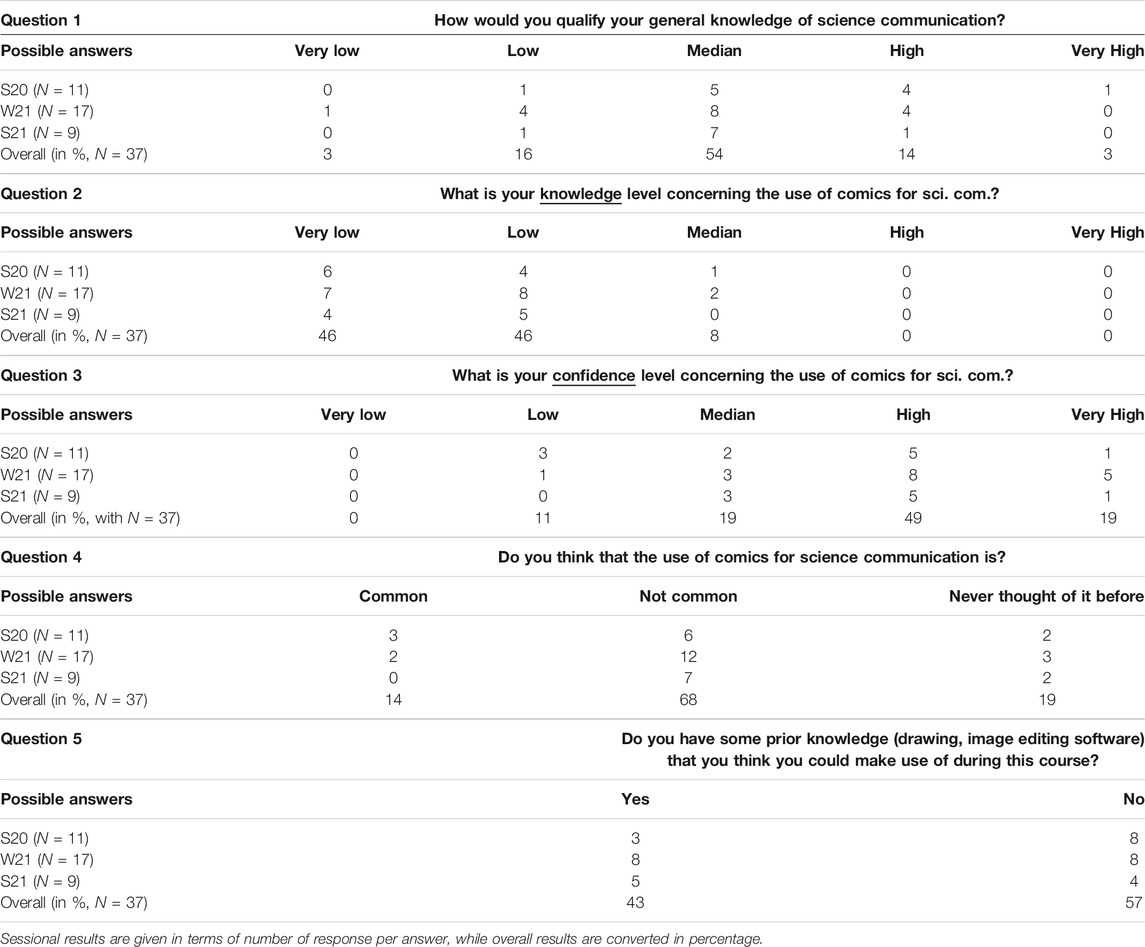
TABLE 1 . Results of the pre-course survey over three teaching sessions.
3.3 First Post-course Survey
This survey’s results are provided in Table 2 . According to the results of this survey, the progression of general knowledge of science communication is mostly considered “Important” with 59 % of the answers. Nearly all students estimate that their knowledge level concerning science communication has largely improved (65% and 32% for “Important” and “Very important” progressions, respectively). Compared with the reported low level at the beginning of the course, this indicator illustrates a large impact on this considered criterion. Another interesting point is that even if the confidence level was already high before following the course, the respondents report that they nevertheless have a large progression concerning this point. Finally, a global increase in terms of knowledge in arts and media is noted, with only 21 % answers reporting a bare improvement in this domain. These results indicate that two of the objectives of such course are achieved, that is, developing transdisciplinary skills and training researchers to science communication. Several students underlined that they had large interest in arts before starting higher education (and being involved into more specialized and intensive teachings) and valued the possibility of combining their interests in different domains.
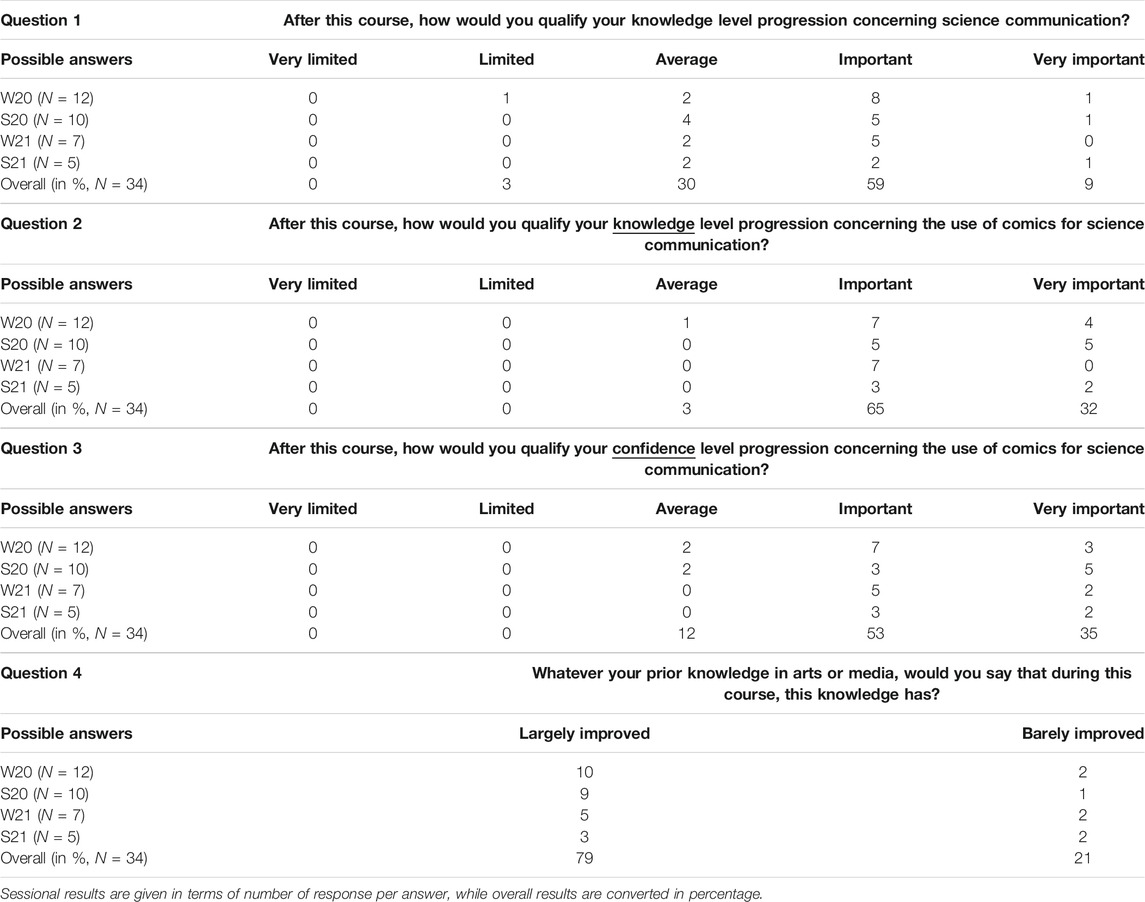
TABLE 2 . Results of the post-course survey over four teaching sessions.
3.4 Second Post-course Survey
This survey aimed at analyzing from the student’s standpoint on how they used comics’ features and elements in their work and how they foresee the use of this work. The corresponding results are provided in Table 3 . The results obtained for Question 1 show that the students choice of a character directly linked to their research or of a character that would be a simple speaker to describe their research is nearly split half. The analysis of students work by the teachers reveals that the choice of a human-like or non-human character was also nearly parted in half. It is as much the object of science as the person doing this science that are thus used to illustrate a research. Answers to Questions 2 and 3 provide interesting information concerning science and its storytelling. The scientific information was deemed clearly transcribed in their work by 67 % of the students, and the remaining 33 % had to modify it to convey their message. The “Storytelling” term for the use of comics in science communication seems appropriate with only 12 % of works being considered a precise description of a research, but not a story ( see Question 3). The answer to Question 4 indicates the general public as the mostly contemplated audience for the work made during the course, with an orientation towards adults. The research area seems not firmly influential on potential university-level readers. Nevertheless, these numbers are weighted by their answer’s occurrence since multiple choices were accepted so that they might be biased.
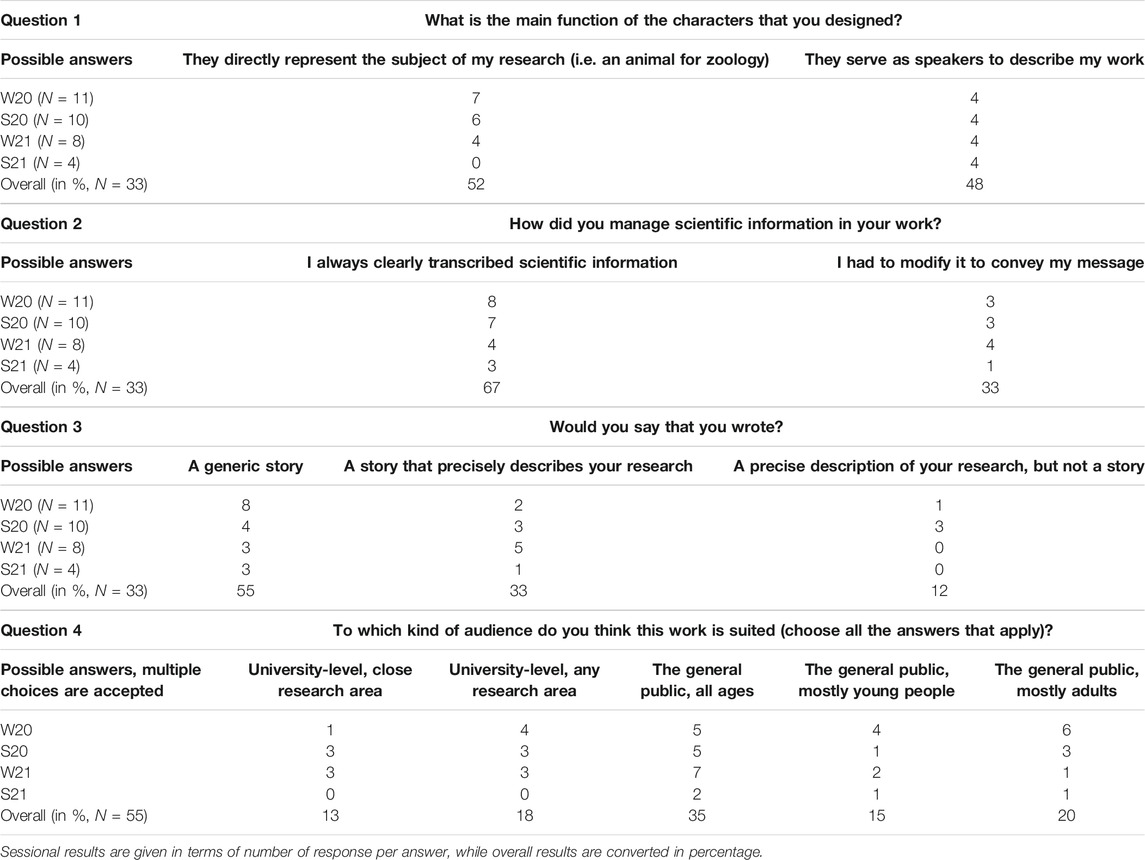
TABLE 3 . Results of the post-course survey over four teaching sessions.
When students were asked if they intended to reuse the work they did during the course and if yes, “In which context?“, the answer was unanimous: 100% of the 33 respondents were willing to reuse this work. The answers to the open-ended question “In which context?” were as follows (ordered in decreasing order of number of occurrences): in a conference presentation, for science communication opportunities or projects, during my PhD defense, in my thesis, to explain my thesis subject to relatives, as a poster for visitors in my lab, for a journal study (supplementary material or graphical abstract), knowledge transfer with partners of a project. This corresponds to the validation of the third objective of the course, that is, to generate concrete contents for science communication. Another open-ended question asked the attendees to provide an adjective to qualify the general tone of their work. The three most cited adjectives were (in decreasing order): humorous, didactic, and documentary. Finally, the last open-ended question was the following: “Would you recommend this course to doctoral students and postdoctoral fellows? If yes, provide a reason why.” The answer was positive for all the respondents, and five reasons why are reported below:
• “Because it allows you to take another look at your doctoral work and to better explain complex notions to people not initiated in the subject. The exchange with other doctoral students is also very beneficial,”
• “This course allows science popularization to be seen in a whole new light,”
• “Because it progresses from an idea to popularize until its complete production,”
• “We think outside the box and the teachers, as well as the exchange with other students, open our horizons. The course has implications for our communication skills beyond the comics-based style,”
• “I would strongly recommend this training to anyone interested in science communication, because it allows you to approach and understand science from another point of view, surely fun but also effective in conveying a message.”
4 Conclusion and Perspectives
This study described a university course which main objective is to help postgraduate students develop their general interest and skills into science communication using comics as a working medium. All testimonies and survey results confirm the interest of such a science communication course that encompasses several domains. The discovery of other research areas and non-specialist point of views were highly appreciated and stimulated motivation in the course. It appears that comic-based science communication is not well known, but accessible. Within a teaching session, it is possible to obtain high quality works that can be used for various purposes. The participants can appreciate a complete science communication process, from an in-depth work to transform a scientific language to an adapted language until a concrete and tangible achievement. Even if science communication and its outcomes remain difficult to evaluate, as pointed out by Fischhoff (2019 ), the significant engagement that is promoted by this course allows us to reach effective and concrete results.
One of the stumbling blocks most often mentioned by participants was their initial self-appraised lack of artistic skills or lack of familiarity with traditional or computerized graphic tools, something that is reflected by the data in Table 1 . Although proper training with classical tools like pencil, pen, and brush would require an extended period, it is quite feasible to guide students through the use of computer-based techniques, including the use of programs especially conceived to draw comics, even with no artistic prior training whatsoever- in just a few hours. This conclusion is shared by Scavone et al. (2019) that point out that it is not only experienced illustrators who can make comic strips, concept cartoons, or even short comic books. The same authors underline that “Even if one does not know how to draw, this should not be a barrier to communicate (…) through the creation of comics.” This is indeed the case in practice according to the presented results and surveys. It is nevertheless underlined that overcoming beliefs of students (and educators) regarding the role of informal reading materials in science education should be systematically considered, since it was identified as a challenge that participants encountered in using comics in Matuk et al. (2021 ).
A series of short videos detailing and demonstrating such resources is already used in the class, and it would doubtless be beneficial to add a few more, particularly ones focusing on technical problems encountered by students of the class’s first cohorts. From the teacher’s point of view, this course concept can be easily adapted to teach other levels like senior undergraduates provided educators have sufficient knowledge concerning comics and science to answer (quite) miscellaneous questions and support students. A growing number of articles or reports underline the positive effect that creating comics have on student learning and teaching, with examples in various domains like engineering ( Barros et al., 2017 ), management ( Barbosa et al., 2017 ), or operations research ( Zamora et al., 2021 ). Some resources that provide step-by-step instructions for the conceptualization and design of comics that are based on scientific publications are readily available ( Friesen et al., 2018 ; McDermott et al., 2018 ).
One point that could be also included in future works is cross-cultural communication. Indeed, all participants could be here considered of the same or close culture so that chosen comic images and language will generally increase communication, which could be further studied if the course was taught in various contexts and for various communities including indigenous ones. Nevertheless, a combination of text and images carrying information (or telling a story) is an approach that was developed by several cultures independently and observed as early as 13th century BCE (Egypt’s Book of the Dead), ancient versions of the Persian epic poem Shahnameh ( see the 14th century Demotte Shahnameh, for example), or 11th century Europe (the Bayeux tapestry). The drive to represent reality in a graphic format seems to be a cross-cultural phenomenon, and widespread enough to have a nearly global appeal.
In the coming courses, starting in Winter 2022 session, new surveys will be also designed to refine assessment of fostered qualities and support continuous improvement of the course. Following the two first sessions, a series of workshops has been opened to a larger community (undergraduate and graduate students, as well as professors) thanks to a science communication grant. One of the most exciting perspectives is the current setup of a book gathering a series of comic-based works. This book will include works conducted within the enlarged community workshops, some of the works produced during the EFD919 course and comics made by professional comics writers on the basis of winning texts from the science popularization contest at Université de Sherbrooke. This book will serve as a unique medium to disseminate science and for science teaching (secondary schools and colleges are especially targeted). Indeed, the question of how produced comics can be further used to support teaching at various levels and the evaluation of their impact will be also considered in future works. Matuk et al. (2021 ) observed “how the use of a comic book series enabled educators to incorporate multiple literacies and disciplinary lenses into their lessons.” They noted that the use of comics helps to increase the diversity of students likely to engage with science, to bridge science and students personal experience, and finally promote engagement, equity, and diversity. The work carried out during all workshops will thus be valued with an effective transfer of scientific knowledge to the university community and the general public.
Data Availability Statement
The raw data supporting the conclusions of this article will be made available by the authors, without undue reservation.
Ethics Statement
Ethical review and approval was not required for the study on human participants in accordance with the local legislation and institutional requirements. Written informed consent for participation was not required for this study in accordance with the national legislation and the institutional requirements. Written informed consent was obtained from the individual(s) for the publication of any potentially identifiable images or data included in this article.
Author Contributions
OR wrote the original draft of this article, setup the surveys, and extracted corresponding data. OR and BL equally implemented the course contents and taught the course. ND supported the course setup as an initial pilot course. All authors equally contributed to the review and editing of the submitted version of this article and approved it.
The printing of a book that will include some works arising from this course is made possible through a Science Communication Skills grant. The extension of the presented workshops to undergraduate students, MSc students, and professors was also achieved through this grant. We acknowledge the support of the Natural Sciences and Engineering Research Council of Canada (NSERC). Nous remercions le Conseil de recherches en sciences naturelles et en génie du Canada (CRSNG) de son soutien. The financial support of Université de Sherbrooke through the Centre compétences recherche + is also acknowledged.
Conflict of Interest
The authors declare that the research was conducted in the absence of any commercial or financial relationships that could be construed as a potential conflict of interest.
Publisher’s Note
All claims expressed in this article are solely those of the authors and do not necessarily represent those of their affiliated organizations, or those of the publisher, the editors, and the reviewers. Any product that may be evaluated in this article, or claim that may be made by its manufacturer, is not guaranteed or endorsed by the publisher.
Acknowledgments
Silouane de Reboul and Julie Frion are thanked for sharing their intermediate and final works that are given in Figures 1 , 2 , respectively. Fatima Bousadra is acknowledged for her helpful suggestions concerning the surveys.
1 https://explorabl.es/
2 https://uqo.ca/emi , https://www.dundee.ac.uk/subjects/comics , https://humanitiesliberalstudies.sfsu.edu/minor-comics-studies
3 www.cartoonscience.org , https://www.datacomics.net/ , https://www.graphicmedicine.org/
4 https://www.stimuli-asso.com/
5 https://sarabandes2016.sciencesconf.org/ , https://tsds2019.sciencesconf.org/
6 https://www.erccomics.com/
Alamalhodaei, A., Alberda, A., and Feigenbaum, A. (2020). “Humanizing Data Through ‘Data Comics’: An Introduction to Graphic Medicine and Graphic Social Science,” in Data Visualization in Society . Editors M. Engebretsen, and H. Kennedy (Amsterdam: Amsterdam University Press ), 201–213. doi:10.5117/9789463722902_ch21
CrossRef Full Text | Google Scholar
Arevalo, V. J. C., Verbrugge, L., Sools, A., Brugnach, M., Wolterink, R., van Denderen, R. P., et al. (2020). Storylines for Practice: A Visual Storytelling Approach to Strengthen the Science-Practice Interface. Sustain. Sci. 10, 1013. doi:10.1007/s11625-020-00793-y
Bach, B., Riche, N. H., Carpendale, S., and Pfister, H. (2017). The Emerging Genre of Data Comics. IEEE Comput. Grap. Appl. 37, 6–13. doi:10.1109/mcg.2017.33
PubMed Abstract | CrossRef Full Text | Google Scholar
Barbosa, A., Tavares, G., and Kruta, A. (2017). The Comics as Teaching Strategy in Learning of Students in an Undergraduate Management Program. RAM Rev. Adm. Mackenzie 18, 40–65. doi:10.1590/1678-69712017/administracao.v18n6p224-224
Barkemeyer, R., Dessai, S., Monge-Sanz, B., Renzi, B. G., and Napolitano, G. (2016). Linguistic Analysis of Ipcc Summaries for Policymakers and Associated Coverage. Nat. Clim Change 6, 311–316. doi:10.1038/nclimate2824
Barros, D. M. R., Begosso, L. R., Fabri, J. A., and L'Erario, A. (2017). “The Use of Comic Strips in the Teaching of Software Engineering,” in 2017 IEEE Frontiers in Education Conference (FIE) , Indianapolis, IN , December 14, 2017 ( IEEE ), 1–8. doi:10.1109/FIE.2017.8190537
Caudron, F., and Barral, Y. (2013). A Super-assembly of Whi3 Encodes Memory of Deceptive Encounters by Single Cells during Yeast Courtship. Cell 155, 1244–1257. doi:10.1016/j.cell.2013.10.046
de Hosson, C., Bordenave, L., Daures, P.-L., Décamp, N., Hache, C., Guediri, N., et al. (2018). Communicating Science Through the Comics Science Workshops: the Sarabandes Research Project. JCOM 17, 10127–10134. doi:10.22323/2.17020203
Doxiadis, A., Papadimitriou, C., Papadatos, A., and Donna, A. D. (2009). Logicomix: An Epic Search for Truth . New York: Bloomsbury Publishing .
Google Scholar
Fahnert, B. (2019). Be Prepared - Learning for the Future. FEMS Microbiol. Lett. 366, fnz200. doi:10.1093/femsle/fnz200
Farinella, M. (2018a). Of Microscopes and Metaphors: Visual Analogy as a Scientific Tool. The comics grid: J. comics scholarship 8, 1–16. doi:10.16995/cg.130
Farinella, M. (2018b). The Potential of Comics in Science Communication. JCOM 17, 1–17. doi:10.22323/2.17010401
Farinella, M. (2018c). Science Comics' Super Powers. Amer. Scientist 106, 218. doi:10.1511/2018.106.4.218
Fischhoff, B. (2019). Evaluating Science Communication. Proc. Natl. Acad. Sci. USA 116, 7670–7675. doi:10.1073/pnas.1805863115
Flemming, D., Cress, U., Kimmig, S., Brandt, M., and Kimmerle, J. (2018). Emotionalization in Science Communication: The Impact of Narratives and Visual Representation on Knowledge Gain and Risk Perception. Front. Comm. 3, 1–9. doi:10.3389/fcomm.2018.00003
Friesen, J., Van Stan, J., and Elleuche, S. (2018). Communicating Science Through Comics: A Method. Publications 6, 38–10. doi:10.3390/publications6030038
Green, S. J., Grorud-Colvert, K., and Mannix, H. (2018). Uniting Science and Stories: Perspectives on the Value of Storytelling for Communicating Science. FACETS 3, 164–173. doi:10.1139/facets-2016-0079
Harder, J. (2015). Alpha . London: Knockabout .
Hillier, A., Kelly, R. P., and Klinger, T. (2016). Narrative Style Influences Citation Frequency in Climate Change Science. PLos One 11, e0167983. doi:10.1371/journal.pone.0167983
Hoffmann, R. (2020). The Tensions of Scientific Storytelling. Am. scientist 102, 250–253.
Hosler, J., and Boomer, K. B. (2011). Are Comic Books an Effective Way to Engage Nonmajors in Learning and Appreciating Science?1. Life Sci. Educ. 10, 309–317. doi:10.1187/cbe.10-07-0090
Hosler, J. (2013). Clan Apis . Scotts Valley, CA: CreateSpace Independent Publishing Platform .
Hureau, M. (2019). La Bande Dessinée Comme Forme Académique. belphegor 17, 1–24. doi:10.4000/belphegor.1882
Jones, M. D., and Crow, D. A. (2017). How Can We Use the 'Science of Stories' to Produce Persuasive Scientific Stories? Palgrave Commun. 3, 1–9. doi:10.1057/s41599-017-0047-7
Katz, Y. (2013). Against Storytelling of Scientific Results. Nat. Methods 10, 1045. doi:10.1038/nmeth.2699
Krzywinski, M., and Cairo, A. (2013). Storytelling. Nat. Methods 10, 687. doi:10.1038/nmeth.2571
Matuk, C., Hurwich, T., Spiegel, A., and Diamond, J. (2021). How Do Teachers Use Comics to Promote Engagement, Equity, and Diversity in Science Classrooms? Res. Sci. Educ. 51, 685–732. doi:10.1007/s11165-018-9814-8
McDermott, J. E., Partridge, M., and Bromberg, Y. (2018). Ten Simple Rules for Drawing Scientific Comics. Plos Comput. Biol. 14, e1005845. doi:10.1371/journal.pcbi.1005845
McNicol, S. (2016). The Potential of Educational Comics as a Health Information Medium. Health Inf. Libraries J. 34, 20–31. doi:10.1111/hir.12145
Morel, M., Peruzzo, N., Rodriguez Juele, A., and Amarelle, V. (2019). Comics as an Educational Resource to Teach Microbiology in the Classroom. J. Microbiol. Biol. Educ. 20, 1–4. doi:10.1128/jmbe.v20i1.1681
Muindi, F. J., Ramachandran, L., and Tsai, J. W. (2020). Human Narratives in Science: The Power of Storytelling. Trends Molecular Medicine 26, 249–251. doi:10.1016/j.molmed.2019.12.001
Nature Chemistry (2011). The Art of Abstracts. Nat. Chem. 3, 571. doi:10.1038/nchem.1109
Nature Methods (2013). Should Scientists Tell Stories? Nat. Methods 10, 1037. doi:10.1038/nmeth.2726
N. H. Riche, C. Hurter, N. Diakopoulos, and S. Carpendale (Editors) (2018). Data-Driven Storytelling (New York: A K Peters/CRC Press ). doi:10.1201/9781315281575
Poisson, Y., Fiesta-Bianchet, M., and Pelletier, F. (2020). Testing the Importance of Harvest Refuges for Phenotypic rescue of Trophy-Hunted Populations. J. Appl. Ecol. 57, 526–535. doi:10.1111/1365-2664.13562
Robin, O., and Jaouen, L. (2019). “Teaching/learning Acoustics through Entertainment?,” in 26th International Congress on Sound and Vibration , Montreal , July 7–11, 2019 , 1–8.
Ross-Hellauer, T., Tennant, J. P., Banelytė, V., Gorogh, E., Luzi, D., Kraker, P., et al. (2020). Ten Simple Rules for Innovative Dissemination of Research. Plos Comput. Biol. 16, e1007704. doi:10.1371/journal.pcbi.1007704
Scavone, P., Carrasco, V., Umpiérrez, A., Morel, M., Arredondo, D., and Amarelle, V. (2019). Microbiology Can Be Comic. FEMS Microbiol. Lett. 366, fnz171. doi:10.1093/femsle/fnz171
Schultz, M., Cannon, Z., and Cannon, K. (2009). The Stuff of Life: A Graphic Guide to Genetics and DNA . 1st Edn. New York: Hill and Wang .
PubMed Abstract | Google Scholar
S. Kirtley, A. Garcia, and P. Carlson (Editors) (2020). Woth Great Power Comes Great Pedagogy - Teaching, Learning and Comics . (Jackson: University Press of Mississippi ).
Sones, W. D. (1944). The Comics and Instructional Method. J. Educ. Sociol. 18, 232–240. doi:10.2307/2262696
Sopinka, N., Coristine, L., DeRosa, M., Rochman, C., Owens, B., and Cooke, S. (2020). Envisioning the Scientific Paper of the Future. FACETS 5, 1–16. doi:10.1139/facets-2019-0012
Sousanis, N. (2015). Unflattening . Cambridge: Harvard University Press .
Spiegel, A. N., McQuillan, J., Halpin, P., Matuk, C., and Diamond, J. (2013). Engaging Teenagers with Science Through Comics. Res. Sci. Educ. 43, 2309–2326. doi:10.1007/s11165-013-9358-x
Tatalovic, M. (2009). Science Comics as Tools for Science Education and Communication: A Brief, Exploratory Study. JCOM 8, 1–17. doi:10.22323/2.08040202
Tisseron, S. (1975). Contribution à l’utilisation de la bande-dessinée comme instrument pédagogique : une tentative graphique sur l’histoire de la psychiatrie. PhD thesis. 1–88.
Tisseron, S. (2009). Passer sa thèse en bandes dessinées. c’est possible et c’est nécessaire ! [defending a doctoral thesis using comics. possible and needed !]. Sociétés 106, 9–13. doi:10.3917/soc.106.0009
Unesco (2015). UNESCO Science Report: Towards 2030 by United Nations Educational, Scientific and Cultural Organization (UNESCO) . Paris: UNESCO Publishing .
Wang, Z., Dingwall, H., and Bach, B. (2019a). “Teaching Data Visualization and Storytelling with Data Comic Workshops,” in CHI 2019 , May 4–9, 2019 ( Glasgow, UK ), 1–9. doi:10.1145/3290607.3299043
Wang, Z., Wang, S., Farinella, M., Murray-Rust, D., Riche, N., and Bach, B. (2019b). “Comparing Effectiveness and Engagement of Data Comics and Infographics,” in CHI 2019 , May 4–9, 2019 ( Glasgow, UK ). doi:10.1145/3290605.3300483
Wertham, F. (1954). Seduction of the Innocent . New York: Rinehart Company .
The Royal Society (2011). Knowledge, Networks and Nations: Global scientific collaboration in the 21st century . London: The Royal Society . .
Zamora, L. P., Bravo, S. S., and Padilla, A. G. (2021). Production of Comics in Powtoon as a Teaching-Learning Strategy in an Operations Research Course. Eur. J. Contemp. Educ. 10, 137–147. doi:10.13187/ejced.2021.1.137
Zhao, Z., Marr, R., and Elmqvist, N. (2015). “Data Comics: Sequential Art for Data-Driven Storytelling,” in HCIL Technical Report HCIL-2015-15 (College Park: University of Maryland ), 1–12.
Keywords: science communication, comics, postgraduate course, research dissemination, survey
Citation: Robin O, Leblanc B and Dumais N (2021) Teaching Science Communication with Comics for Postgraduate Students. Front. Commun. 6:758198. doi: 10.3389/fcomm.2021.758198
Received: 13 August 2021; Accepted: 17 September 2021; Published: 27 October 2021.
Reviewed by:
Copyright © 2021 Robin, Leblanc and Dumais. This is an open-access article distributed under the terms of the Creative Commons Attribution License (CC BY). The use, distribution or reproduction in other forums is permitted, provided the original author(s) and the copyright owner(s) are credited and that the original publication in this journal is cited, in accordance with accepted academic practice. No use, distribution or reproduction is permitted which does not comply with these terms.
*Correspondence: Olivier Robin, [email protected]

PhD Comics- Fun Things to PhD!
Doing a PhD is a tedious job we know it right. It is really a serious business to do and that is why it is designated as the highest level of honor in the education system.
The era is of the internet, people are busy doing so much work and social media, rest of the time. Interestingly some people on the internet have created unique things related to PhD, a comic!
A PhD comic makes you laugh and you feel connected immediately because the things are somehow we had faced during our PhD.
So let’s check out some good PhD Comics.
Note: all these PhD comics are taken from the www.phdcomics.com . Their collection is incredible. All images are copyright to the phdcomics.
The first one is the marriage vs the PhD.
The highlight of the comic is that, “foolish young people in love ended in marriage and foolish young people without a job ended in PhD.”
Marriage vs PhD
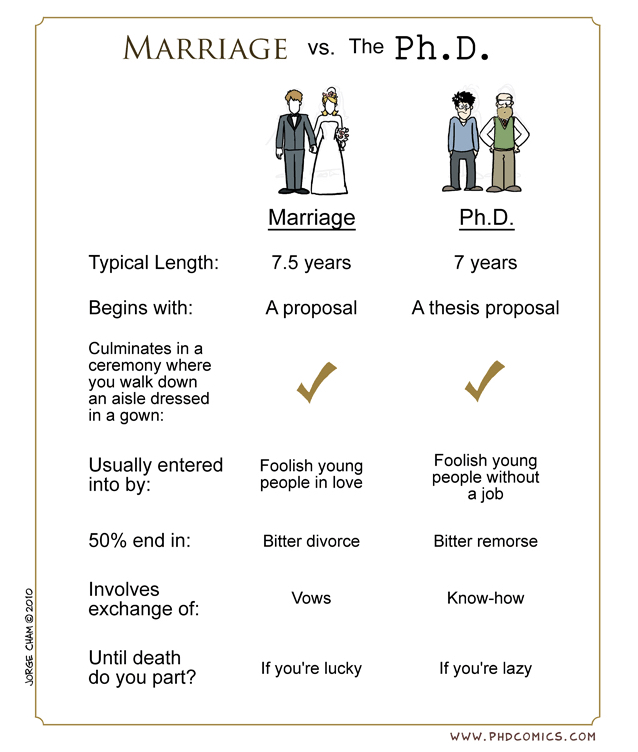
Average time spent composing one email:
This one is a good punch. We should have to write an email with detail and also with “respect”, and our PhD supervisor replies in a single word. That happens to all.
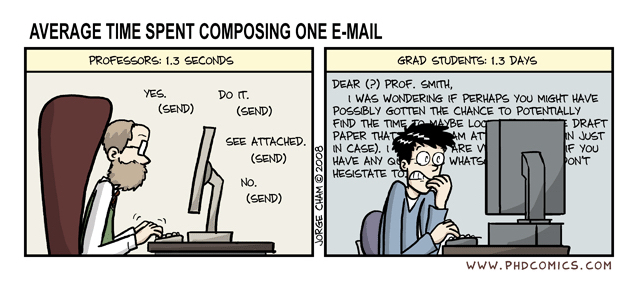
Motivational level graph:
As we starts our PhD we are filled with motivations but as time passes the motivation goes down and frustration level increases.
Every one has faced this final.doc things! even after competing my PhD, i have so many Final.doc, finallll.doc, final01.doc and finallufinal.doc files on my laptop. See the comic:
World cup vs the PhD:
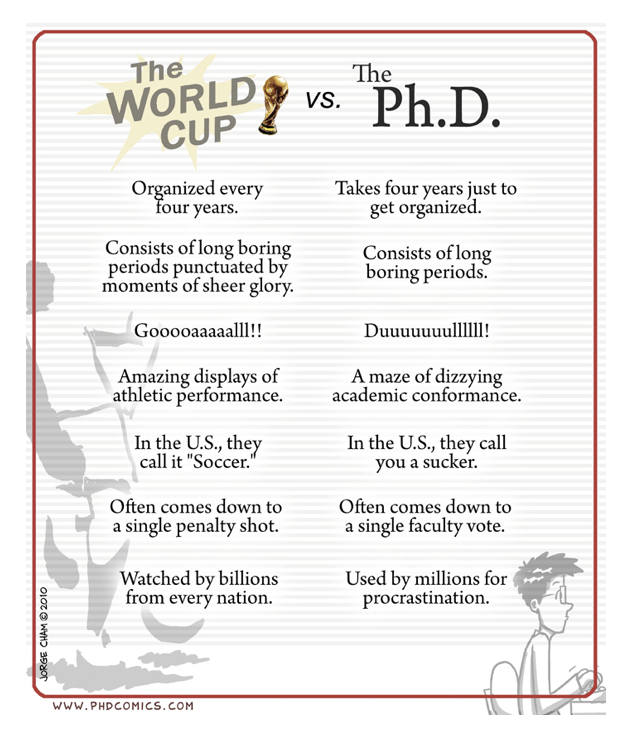
Your thesis committee:
Now this one is a catchy, “impossibly difficult group to get together in one room”. It is true. when we are facing viva none of the faculties have completely read our thesis and though they are giving us suggestions.
Moreover, all have different and opposite openions. but “the guru” is my favourite, only come to get cookies.
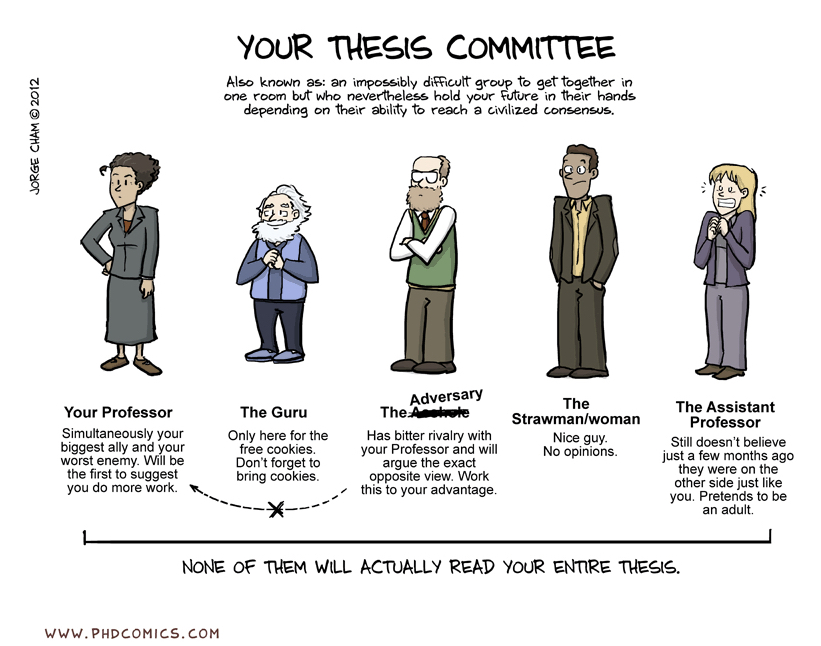
Ninja vs professors:
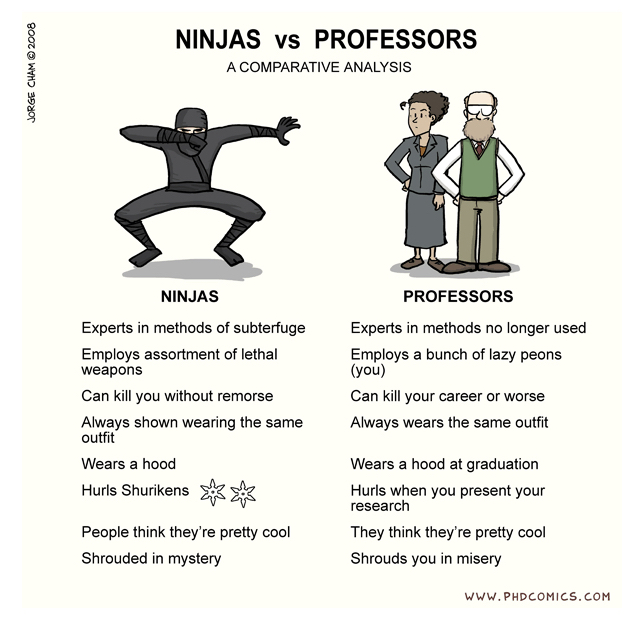
Your computer desktop
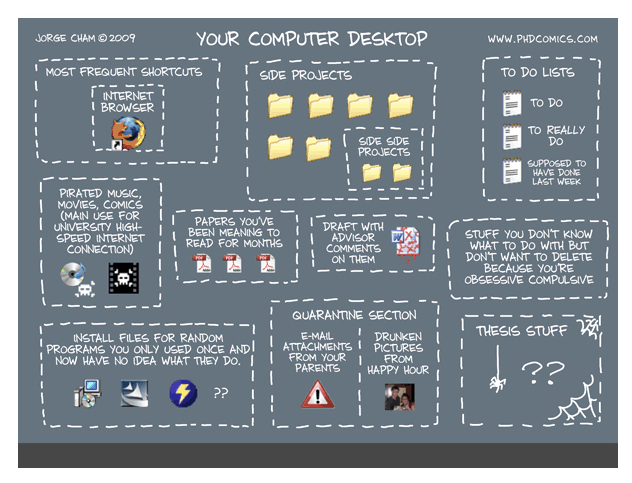
happening outside’
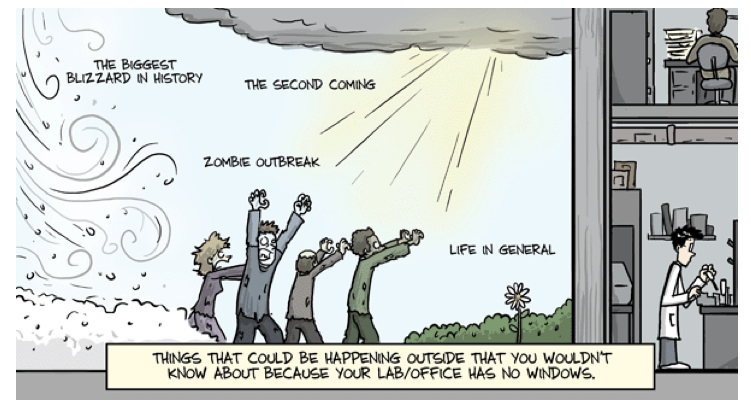
The origin of the thesis
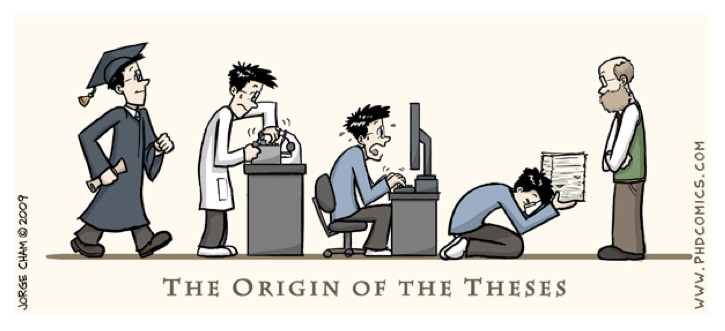
Take it out:
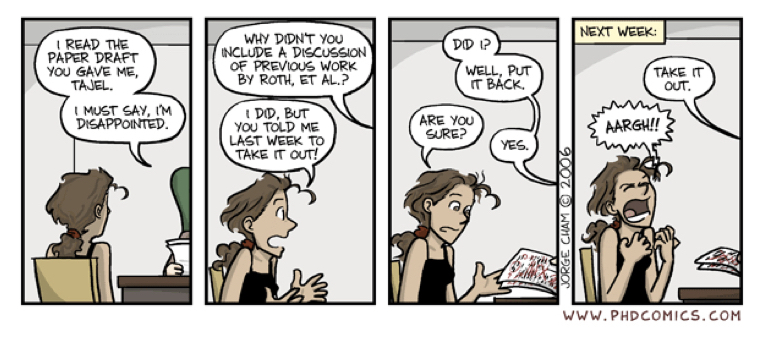
Draft approved
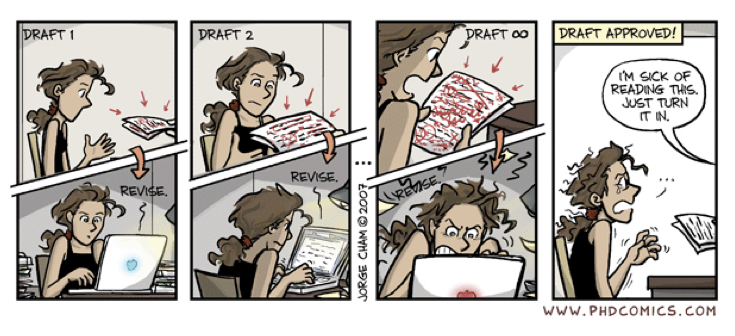
Dr. Tushar Chauhan is a Scientist, Blogger and Scientific-writer. He has completed PhD in Genetics. Dr. Chauhan is a PhD coach and tutor.
Share this:

- Share on Facebook
- Share on Twitter
- Share on Pinterest
- Share on Linkedin
- Share via Email
About The Author

Dr Tushar Chauhan
Related posts.
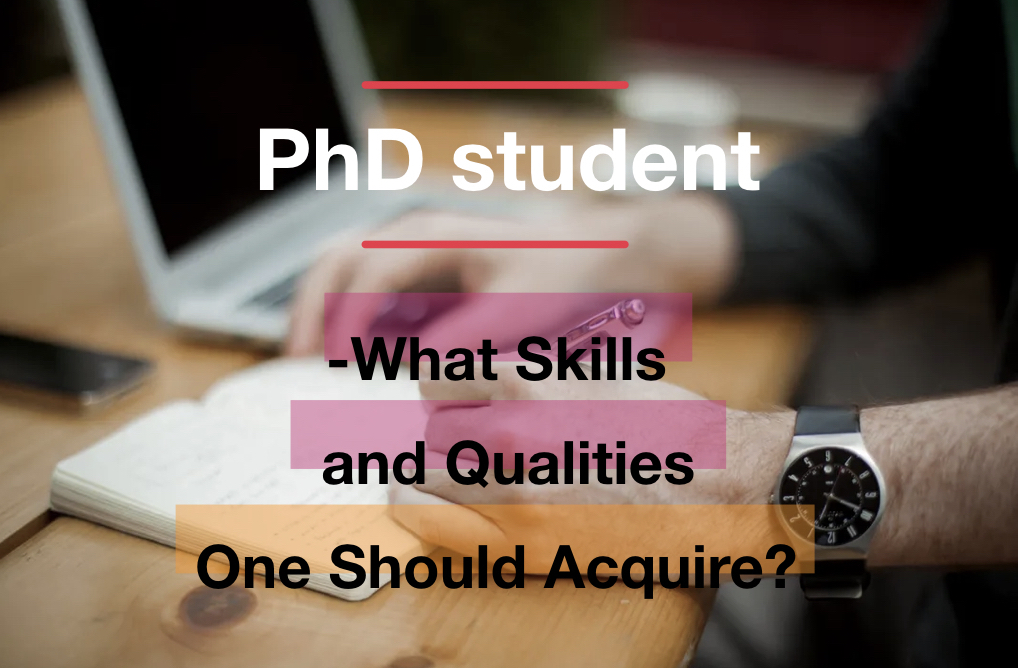
PhD student- What Skills and Qualities One Should Acquire?
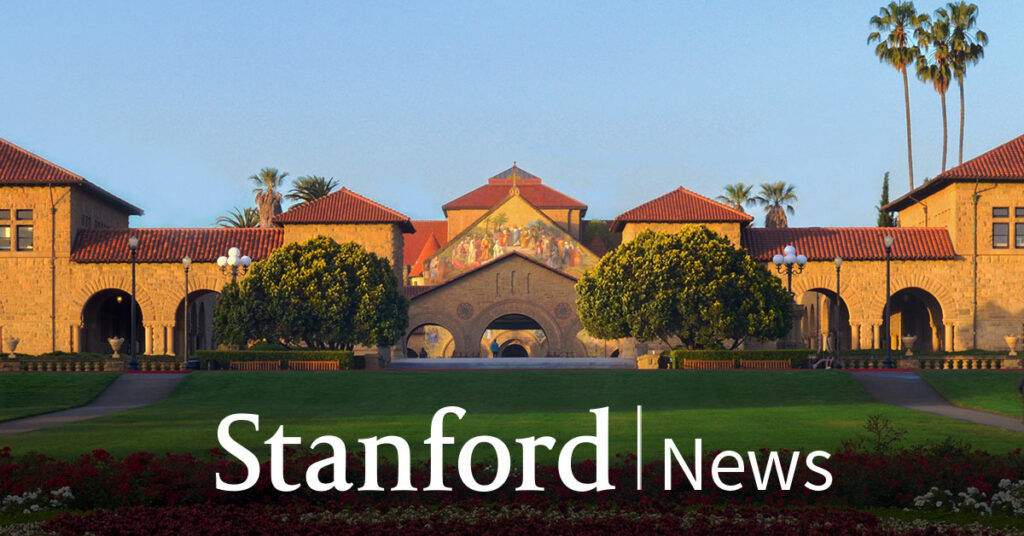
Current PhD programs at Stanford: 2020-21
Leave a comment cancel reply.
Your email address will not be published. Required fields are marked *
Save my name, email, and website in this browser for the next time I comment.
Notify me of follow-up comments by email.
Notify me of new posts by email.

- Comics & Graphic Novels
- Comic Strips

Enjoy fast, free delivery, exclusive deals, and award-winning movies & TV shows with Prime Try Prime and start saving today with fast, free delivery
Amazon Prime includes:
Fast, FREE Delivery is available to Prime members. To join, select "Try Amazon Prime and start saving today with Fast, FREE Delivery" below the Add to Cart button.
- Cardmembers earn 5% Back at Amazon.com with a Prime Credit Card.
- Unlimited Free Two-Day Delivery
- Streaming of thousands of movies and TV shows with limited ads on Prime Video.
- A Kindle book to borrow for free each month - with no due dates
- Listen to over 2 million songs and hundreds of playlists
- Unlimited photo storage with anywhere access
Important: Your credit card will NOT be charged when you start your free trial or if you cancel during the trial period. If you're happy with Amazon Prime, do nothing. At the end of the free trial, your membership will automatically upgrade to a monthly membership.
Return this item for free
Free returns are available for the shipping address you chose. You can return the item for any reason in new and unused condition: no shipping charges
- Go to your orders and start the return
- Select the return method

Download the free Kindle app and start reading Kindle books instantly on your smartphone, tablet, or computer - no Kindle device required .
Read instantly on your browser with Kindle for Web.
Using your mobile phone camera - scan the code below and download the Kindle app.

Image Unavailable

- To view this video download Flash Player

PHD Comics 20th Anniversary Book: The 6th Piled Higher and Deeper Comic Strip Collection Paperback – September 29, 2018
Purchase options and add-ons.
- Print length 200 pages
- Language English
- Publisher Piled Higher and Deeper Publishing, LLC
- Publication date September 29, 2018
- Dimensions 9 x 0.5 x 7.25 inches
- ISBN-10 0972169563
- ISBN-13 978-0972169561
- See all details

Frequently bought together

Customers who viewed this item also viewed

Editorial Reviews
About the author, product details.
- Publisher : Piled Higher and Deeper Publishing, LLC; Anniversary edition (September 29, 2018)
- Language : English
- Paperback : 200 pages
- ISBN-10 : 0972169563
- ISBN-13 : 978-0972169561
- Item Weight : 12.8 ounces
- Dimensions : 9 x 0.5 x 7.25 inches
- #716 in Comic Strips (Books)
- #9,582 in Humor (Books)
Customer reviews
Customer Reviews, including Product Star Ratings help customers to learn more about the product and decide whether it is the right product for them.
To calculate the overall star rating and percentage breakdown by star, we don’t use a simple average. Instead, our system considers things like how recent a review is and if the reviewer bought the item on Amazon. It also analyzed reviews to verify trustworthiness.
- Sort reviews by Top reviews Most recent Top reviews
Top reviews from the United States
There was a problem filtering reviews right now. please try again later..
- Amazon Newsletter
- About Amazon
- Accessibility
- Sustainability
- Press Center
- Investor Relations
- Amazon Devices
- Amazon Science
- Sell on Amazon
- Sell apps on Amazon
- Supply to Amazon
- Protect & Build Your Brand
- Become an Affiliate
- Become a Delivery Driver
- Start a Package Delivery Business
- Advertise Your Products
- Self-Publish with Us
- Become an Amazon Hub Partner
- › See More Ways to Make Money
- Amazon Visa
- Amazon Store Card
- Amazon Secured Card
- Amazon Business Card
- Shop with Points
- Credit Card Marketplace
- Reload Your Balance
- Amazon Currency Converter
- Your Account
- Your Orders
- Shipping Rates & Policies
- Amazon Prime
- Returns & Replacements
- Manage Your Content and Devices
- Recalls and Product Safety Alerts
- Conditions of Use
- Privacy Notice
- Consumer Health Data Privacy Disclosure
- Your Ads Privacy Choices
Thank you for visiting nature.com. You are using a browser version with limited support for CSS. To obtain the best experience, we recommend you use a more up to date browser (or turn off compatibility mode in Internet Explorer). In the meantime, to ensure continued support, we are displaying the site without styles and JavaScript.
- View all journals
- Explore content
- About the journal
- Publish with us
- Sign up for alerts
- News Q&A
- Published: 16 September 2011
PhD comics hits the big screen
- Zoë Corbyn
Nature ( 2011 ) Cite this article
241 Accesses
84 Altmetric
Metrics details
- Science in culture
Movie makes stars out of real-life scientists.
This is a preview of subscription content, access via your institution
Access options
Subscribe to this journal
Receive 51 print issues and online access
185,98 € per year
only 3,65 € per issue
Buy this article
- Purchase on Springer Link
- Instant access to full article PDF
Prices may be subject to local taxes which are calculated during checkout
You can also search for this author in PubMed Google Scholar
Related links
Related links in nature research.
Nature's Future of the PhD special
Related external links
The PhD Movie (including latest screening schedule)
Rights and permissions
Reprints and permissions
About this article
Cite this article.
Corbyn, Z. PhD comics hits the big screen. Nature (2011). https://doi.org/10.1038/news.2011.542
Download citation
Published : 16 September 2011
DOI : https://doi.org/10.1038/news.2011.542
Share this article
Anyone you share the following link with will be able to read this content:
Sorry, a shareable link is not currently available for this article.
Provided by the Springer Nature SharedIt content-sharing initiative
Quick links
- Explore articles by subject
- Guide to authors
- Editorial policies
Sign up for the Nature Briefing newsletter — what matters in science, free to your inbox daily.
Quick links
- Make a Gift
- Directories
ENGL 204 B: Popular Fiction and Media
Autumn 2024 View in MyPlan View in Time Schedule Meeting: TTh 12:30pm - 2:20pm / SMI 407 SLN: 23664 Section Type: Lecture Catalog Description: Introduces students to the study of popular culture, possibly including print or visual media, understood as sites of critical reflection. Particular attention to dynamics of production and reception, aesthetics and technique, and cultural politics. Topics may foreground genres (science fiction; romance) or forms (comics; graffiti). Offered: S. GE Requirements Met: Arts and Humanities (A&H) Writing (W) Credits: 5.0 Status: Active Last updated: May 8, 2024 - 5:40 pm
- Newsletter

IMAGES
VIDEO
COMMENTS
view comic: 3225: Addressing Reviewer Comments' view comic: 3215: Average time spent writing one e-mail' view comic: 2888: Analysis of Value' view comic: 2849: Abstract Mad Libs' view comic: 2840: Graph - Motivation level' view comic: 2772: Science News Cycle' view comic: 2563: Your Life Ambition' view comic: 2469: We're all doomed' view comic ...
NEW BOOK! Pre-order now! - I'm SUPER excited to announce my new book Oliver's Great Big Universe is now available to order! It's funny, heart-warming and full of awesome science. Please check it out! NEW TV SHOW! - Check out ELINOR WONDERS WHY the new animated TV show for young kids I co-created! It's about Nature and encouraging kids to follow ...
A PhD Comics special on the occasion of Open Access Week 2012. Piled Higher and Deeper (also known as PhD Comics) is a newspaper and webcomic strip written and drawn by Jorge Cham that follows the lives of several grad students.First published in 1997 when Cham was a grad student himself at Stanford University, the strip deals with issues of life in graduate school, including the difficulties ...
Thesis writing : 1/5/2000: Conference paper : 1/7/2000: So long as we`re not kidding ourselves : 1/12/2000: So long as we`re not kidding ourselves : ... How funny you find PHD Comics : 7/29/2015: Academic Deadlines : 8/7/2015: A Grammatical Conundrum : 8/31/2015: Attachment : 9/4/2015: Sharing : 9/9/2015: Vacation Equation : 9/11/2015: Self ...
For PhD candidates, this experience of writing comics is a step towards improving their ability to popularise science. It can be combined with other programmes run by Université or the MESR, such as 'Ma Thèse en 180 secondes' (My Thesis in 180 seconds) or the annual Science Festival.
Kay Sohini is a comics-maker and PhD candidate in English at Stony Brook University. She is currently drawing her doctoral dissertation as a comic, which is an auto/ethnographic project about race, gender and illness politics. Her work on comics has been published in Inside Higher Ed, Sequentials, Assay: A Journal of Non-fiction Studies ...
Ponder. Hypothesize. Discover. PHD illustrates and communicates the ideas, stories and personalities of researchers, scientists and scholars worldwide in creative, compelling, funny and truthful ...
Out there, somewhere, is a woman who writes about comics who wants to turn that writing to a comics dissertation or thesis, or at least I sure hope there is! The field is wide open and ready for more. For the uninitiated, a dissertation or thesis is the long essay or project that serves as the capstone for most advanced degrees (especially ...
Jorge Cham, creator of the cult comic strip Piled Higher and Deeper, or PHD, is probably the most gut-achingly funny/tragic counsellor you could recommend to a PhD student -- or to any confounded ...
The comic is known for its humor, insight, and relatability. PHD Comics was launched in 1997 and has quickly become a favorite among graduate students and academics alike. The comic has won numerous awards, including the Web Cartoonists' Choice Award for Outstanding Comic Strip.
UF is one of the premier academic institutions for studying comics, animation and other forms of visual rhetoric in North America. For MA and PhD students, there is the option of choosing the Comics and Visual Rhetoric track when pursuing a degree. The presence of the library's ever-expanding special collection of comics, the online journal ImageText, the annual comics conference and ...
The perfect grad student and a chocoholic, it took years for Cecilia to admit she is, in fact, a geek. Brilliant, wily, and usually napping, Mike has been in grad school longer than anyone can remember. His wife and auxiliary source of funding (i.e. "Sugar Mama"), Jen, is hoping he'll graduate soon. Very soon.
Publish " Piled Higher and Deeper " (PHD), the popular comic strip about life (or the lack thereof) in grad school. It's free to student newspapers! Though they represent a significant portion of the campus population, grad students often feel ignored and don't pick up the school newspaper. PHD comics gives them something they can relate to and ...
PhD Comics cover a wide range of topics related to the academic and research life of a PhD student. This includes topics such as the dissertation process, research methods, funding, conferences, grant writing, academic careers, and more. Are the PhD Comics available in print? Yes, the PhD Comics are available in print as well as digitally.
Piled Higher and Deeper. 417,187 likes · 56 talking about this. "Piled Higher and Deeper" (PhD) is the comic strip about life (or the lack thereof) in academia.
PHD (Piled Higher & Deeper) is a Satire webcomic by Jorge Cham that has been running since 1997.. The comics depict the typical life of graduate students in Stanford University: how they obsess about ever getting their theses completed, struggle to make ends meet with their meager stipends, wonder why life is passing them by, and slack off while their supervisors aren't looking.
Matt Pickles. 11 Jul 2016. A new research network about comics and graphic novels has been set up by The Oxford Centre for Research in the Humanities (TORCH). Called 'Comics and Graphic Novels: The Politics of Form', the network will look at questions like why comics are not deemed 'academic' and whether traditional critical approaches ...
The three objectives of the course are 1) to train researchers to science communication, 2) to help them develop transdisciplinary skills, and 3) to generate concrete contents for science communication. Over the four teaching sessions, 42 students followed and passed the course. Among them, 45% were women ( N = 19), 55% were men ( N = 23), and ...
A PhD comic makes you laugh and you feel connected immediately because the things are somehow we had faced during our PhD. So let's check out some good PhD Comics. Note: all these PhD comics are taken from the www.phdcomics.com. Their collection is incredible. All images are copyright to the phdcomics. The first one is the marriage vs the PhD.
Celebrate 20 years of PHD Comics with us! This sixth collection of comics continues the saga of Cecilia, Mike Slackenerny, Tajel and the Nameless Hero as they deal with tough advisors, frustrating undergrads and writing their thesis. This collection contains exclusive essays by Jorge Cham on why he started drawing the comics, who inspired the ...
Credit: Ben Deverman. The creator of the popular online comic strip ' Piled Higher and Deeper ' has turned it into a feature film. The PhD Movie, which opened this week at a handful of US ...
Introduces students to the study of popular culture, possibly including print or visual media, understood as sites of critical reflection. Particular attention to dynamics of production and reception, aesthetics and technique, and cultural politics. Topics may foreground genres (science fiction; romance) or forms (comics; graffiti). Offered: S.